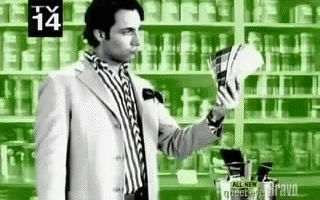Bad Taste Kill$: Redecorating Heteropatriarchy with Queer Eye for the Straight Guy
by Adjustments Agency "’Homosexuality, dope, immorality generally—these are the enemies of strong societies. The upper class of San Francisco is that way. It's not just the ratty part of town. The Bohemian Grove, which I attend from time to time—it is the most faggy goddamned thing you could ever imagine, with that San Francisco crowd. I don’t even want to shake hands with anybody from San Francisco. Decorators. They’ve got to do something ... but goddamn it we don’t have to glorify it.’” — Richard Nixon, 1971
“Lack of ornament is a sign of spiritual strength.” — Adolf Loos, 1910
Architecture and interior decorating are both chiefly concerned with the design and arrangement of space, but the two professions are considered firmly distinct. Since the modern period, whose architectural torchbearers derided the ornamentation favored in past architectural traditions, "architecture" has referred primarily to the design of a building’s form and structure, while “decorating” has become the art of the interior—the realm of softer materials, pigments, and ornament. This distinction became a binary, with architecture always hierarchically above decorating. Each discipline comes with associations far beyond formalist confines. “All art is erotic,” writes early modernist architect Adolf Loos in his seminal 1910 essay "Ornament and Crime," “...the man of our own times who covers the walls with erotic images from an inner compulsion is a criminal or a degenerate.”
From this period, interior decoration has been regarded as a feminine trade—frivolous, materialistic, wasteful, excessive—and strongly associated with homosexuality. Its aspersion is, no doubt, related to these associations. The modern man must cast off such trivial concerns to “[concentrate] his own powers of invention on other things,” and comes to understand his identity, and his self-estimation, by that which he is not or does not wish to be. The hegemonic separation of architecture and interior decoration becomes a significant tool to bolster the perceived degeneracy of homosexuality by relating the decorating arts with economic and social stagnation.
The sexual liberation movement of the late 20th century yielded stronger public visibility and celebration of contemporary gay life. While traditional hierarchies remain firmly in place—as evidenced by former President Richard Nixon’s quote about San Francisco decorators—the homosexual as tastemaker has emerged as a prominent fixture in contemporary popular culture. The hit millennial TV show Queer Eye for the Straight Guy, for example, is a reality show where five gay men are sent to rescue sloppy heterosexual men with grooming tips and an apartment makeover. The show positions gay men as possessing an almost superpower-level superior knowledge of good taste and style—something innate and immutable. While the show attempted to garner greater public acceptance of homosexuality (and in many ways it succeeded), it did so by codifying sexual identity into a set of performances and aesthetic preferences, which, not so coincidentally, are market-friendly. Almost a century after Loos, the association between homosexuality and ornamentation remains firm, but is divested of criminality by its cooperative relationship with capital. A series of critical annotations of one of Queer Eye’s early episodes attempts to expose this complex relationship between sexuality and space.
"Meet the Folks: Alan C" SEASON 1, EPISODE 11 (originally aired September 23, 2003)
CAST
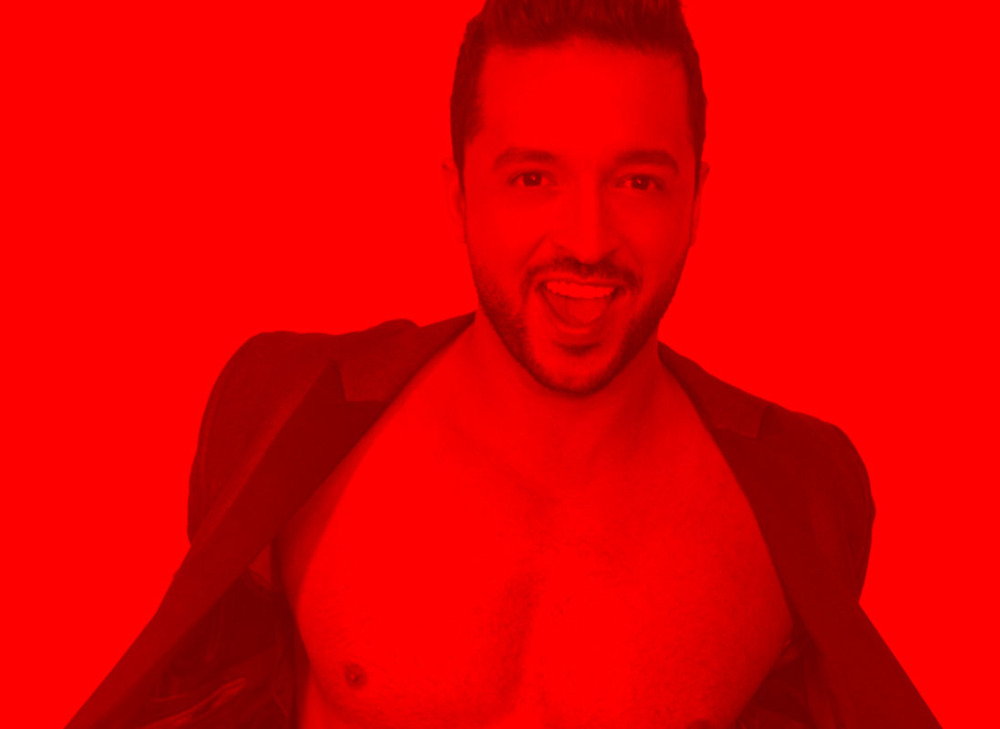 JAI RODRIGUEZ is a 37-year-old actor and musician, originally from Brentwood, NY. Jai is Queer Eye’s "Culture Vulture," coaching the Fab Five’s heterosexual protegés in the subjects of art, fashion, and music as well as social skills such as body language, etiquette, and dating tips. Jai has appeared in a number of on- and off-screen TV and theater productions, such as Rent, Zanna, Don’t, The Producers, the music video for Beyoncé and Lady Gaga’s "Telephone," and How I Met Your Mother. Jai is the only non-original member of the Fab Five (appearing as a replacement in the third episode). He is the youngest of the group, and the only person of color.
JAI RODRIGUEZ is a 37-year-old actor and musician, originally from Brentwood, NY. Jai is Queer Eye’s "Culture Vulture," coaching the Fab Five’s heterosexual protegés in the subjects of art, fashion, and music as well as social skills such as body language, etiquette, and dating tips. Jai has appeared in a number of on- and off-screen TV and theater productions, such as Rent, Zanna, Don’t, The Producers, the music video for Beyoncé and Lady Gaga’s "Telephone," and How I Met Your Mother. Jai is the only non-original member of the Fab Five (appearing as a replacement in the third episode). He is the youngest of the group, and the only person of color.
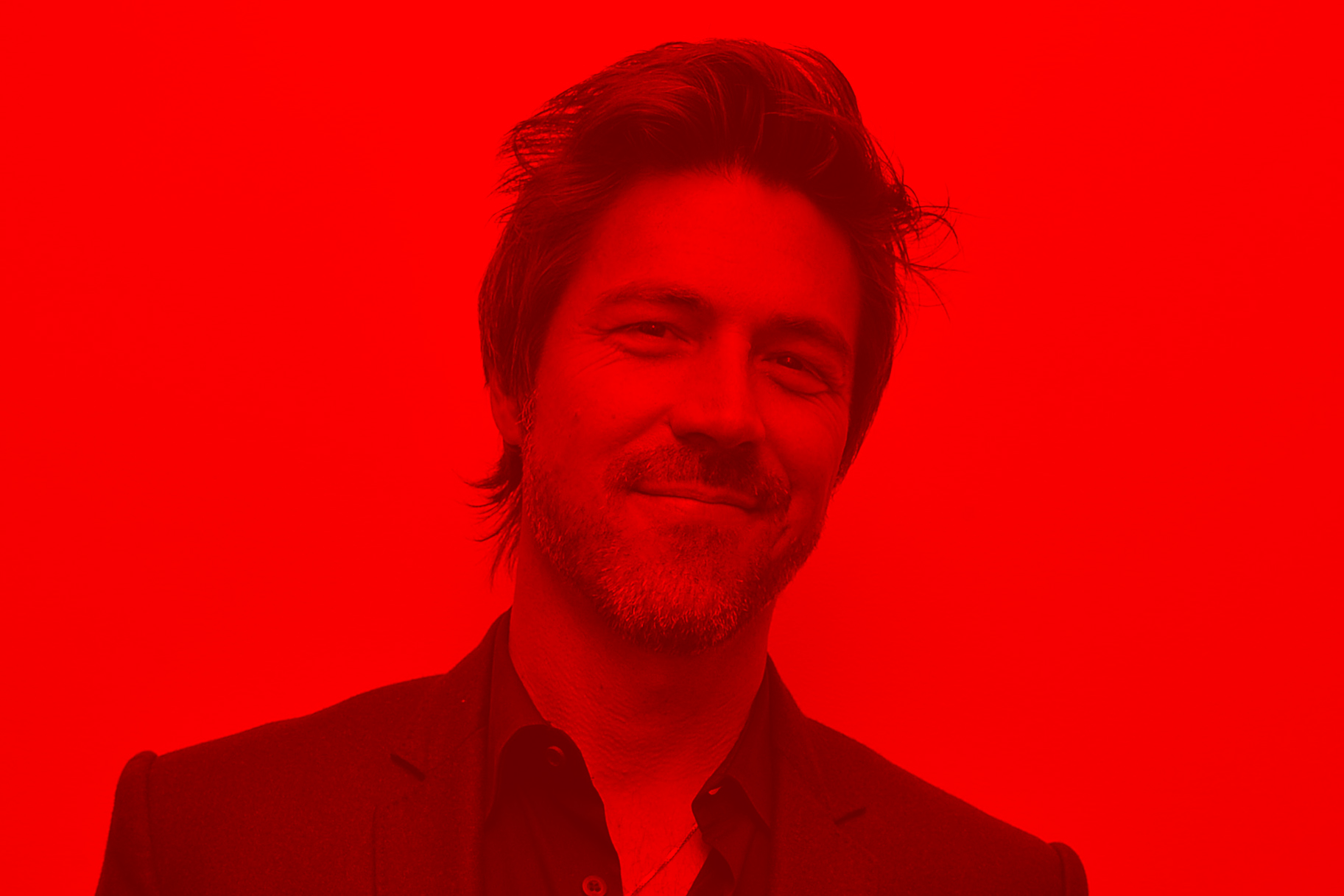 KYAN DOUGLAS is a 46-year-old TV personality and personal stylist, originally from Miami. Kyan Douglas is Queer Eye's "Grooming Guru," coaching the heterosexual subject in hair styling, body, and skincare. Kyan was cast on the show in 2003 after working for Aveda and Arrojo salons in NYC. Kyan published a book Beautified, with grooming tips for women and was a product advisor and spokesperson for L'Oreal in 2004. Kyan hosted TLC's show Ten Years Younger in 2008.
KYAN DOUGLAS is a 46-year-old TV personality and personal stylist, originally from Miami. Kyan Douglas is Queer Eye's "Grooming Guru," coaching the heterosexual subject in hair styling, body, and skincare. Kyan was cast on the show in 2003 after working for Aveda and Arrojo salons in NYC. Kyan published a book Beautified, with grooming tips for women and was a product advisor and spokesperson for L'Oreal in 2004. Kyan hosted TLC's show Ten Years Younger in 2008.
THOM FILICIA is a 47-year-old interior designer from Syracuse, NY. He is the founder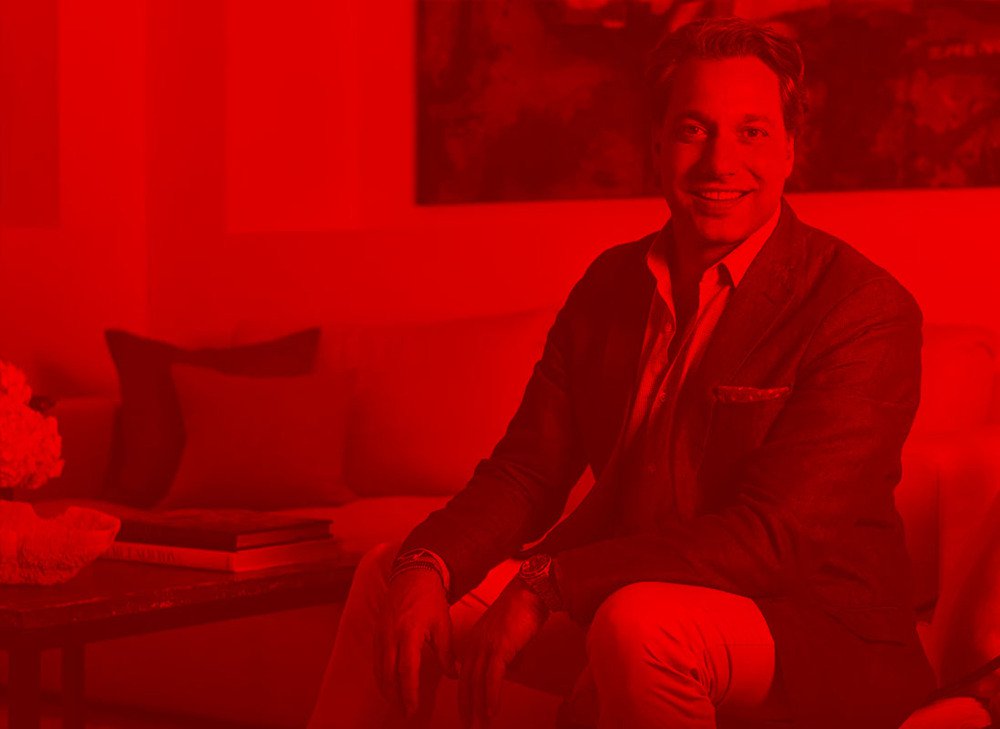 of interior decorating firm Thom Filicia Inc. He was cast as Queer Eye’s interior design expert in 2003. In the show, he works behind the scenes with a small team to transform the interior decor of the subject’s apartment. He has gone on to do the interior design for various projects, such as the VIP Suite for the US Pavilion at the World’s Fair in Aichi, Japan, and an eco-friendly apartment for Riverhouse, Manhattan’s first premium, LEED certified "green" luxury condominium tower.
of interior decorating firm Thom Filicia Inc. He was cast as Queer Eye’s interior design expert in 2003. In the show, he works behind the scenes with a small team to transform the interior decor of the subject’s apartment. He has gone on to do the interior design for various projects, such as the VIP Suite for the US Pavilion at the World’s Fair in Aichi, Japan, and an eco-friendly apartment for Riverhouse, Manhattan’s first premium, LEED certified "green" luxury condominium tower.
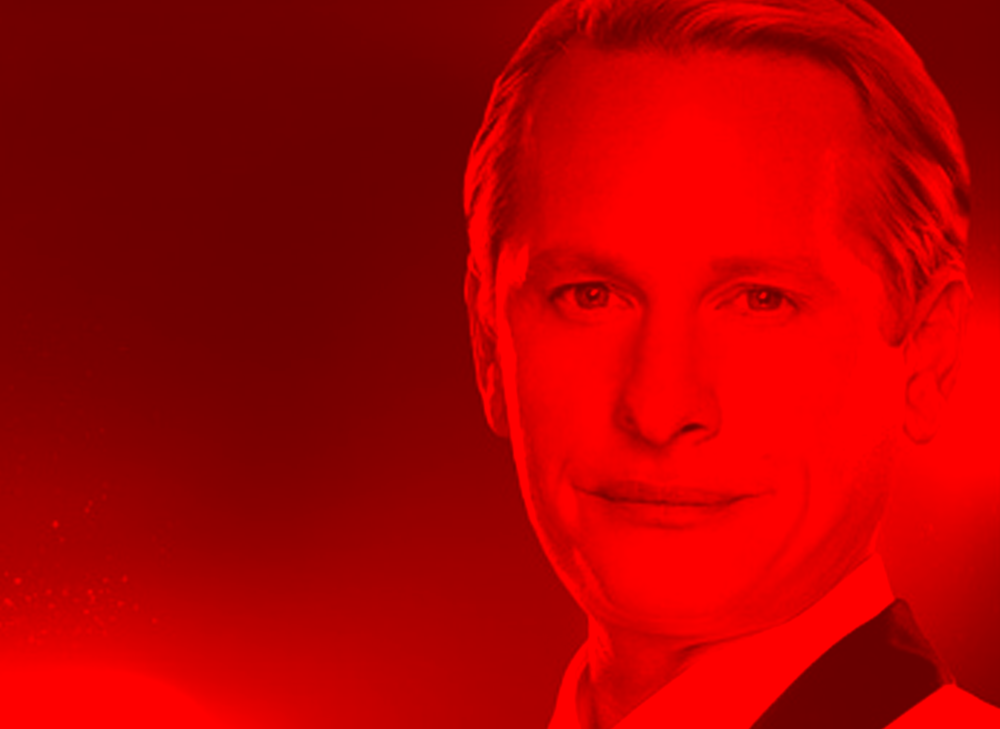 CARSON KRESSLEY is a 47-year-old TV personality, actor and designer from Allentown, PA. He was cast as Queer Eye’s "Fashion Expert," coaching each heterosexual subject on their sartorial choices. Carson emerged as the show’s unofficial frontman, known for his sharp tongue and outgoing personality. Since the show, Carson has appeared on numerous reality TV shows, such as How to Look Good Naked, Carson Nation, and is a recurring judge on RuPaul’s Drag Race.
CARSON KRESSLEY is a 47-year-old TV personality, actor and designer from Allentown, PA. He was cast as Queer Eye’s "Fashion Expert," coaching each heterosexual subject on their sartorial choices. Carson emerged as the show’s unofficial frontman, known for his sharp tongue and outgoing personality. Since the show, Carson has appeared on numerous reality TV shows, such as How to Look Good Naked, Carson Nation, and is a recurring judge on RuPaul’s Drag Race.
TED ALLEN is a 51-year-old author and television personality from Columbus, OH. He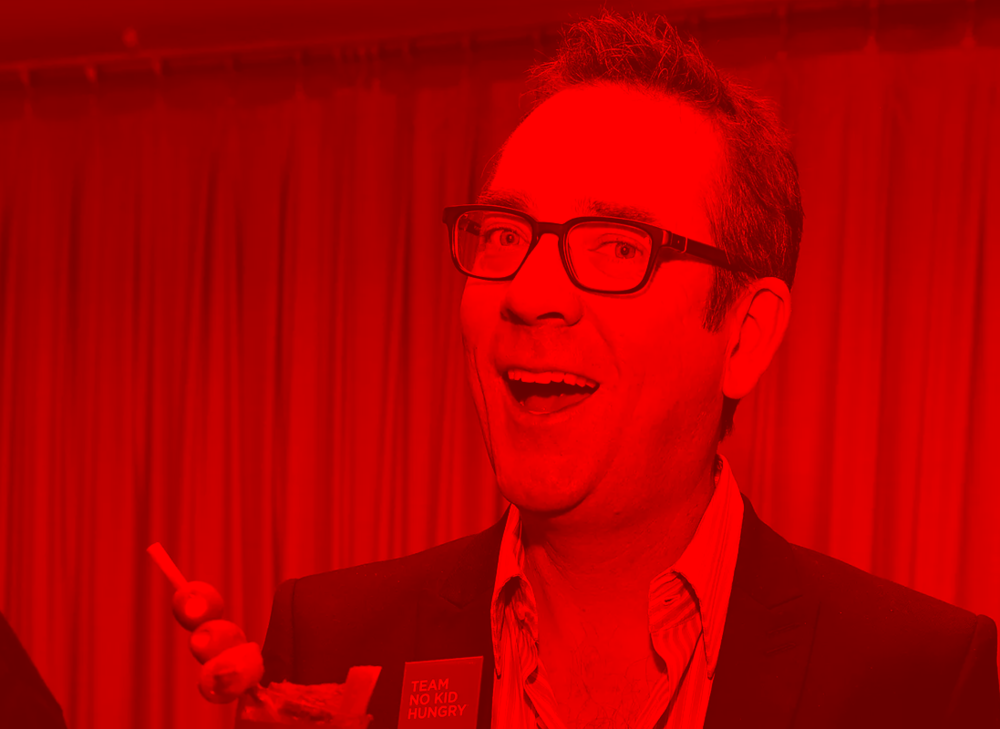 was Queer Eye’s food and wine connoisseur, coaching the show’s subjects on cultivating better cooking and entertaining techniques. Since Queer Eye, he has hosted of the TV cooking competition series Chopped since in 2009, as well as Chopped Junior, which began in mid-2015. In 2014, he became the host of another Food Network show, All-Star Academy. He is a longtime contributing writer for Esquire magazine, the author of two cookbooks, and regularly appears on television cooking shows including the Food Network's The Best Thing I Ever Ate.
was Queer Eye’s food and wine connoisseur, coaching the show’s subjects on cultivating better cooking and entertaining techniques. Since Queer Eye, he has hosted of the TV cooking competition series Chopped since in 2009, as well as Chopped Junior, which began in mid-2015. In 2014, he became the host of another Food Network show, All-Star Academy. He is a longtime contributing writer for Esquire magazine, the author of two cookbooks, and regularly appears on television cooking shows including the Food Network's The Best Thing I Ever Ate.
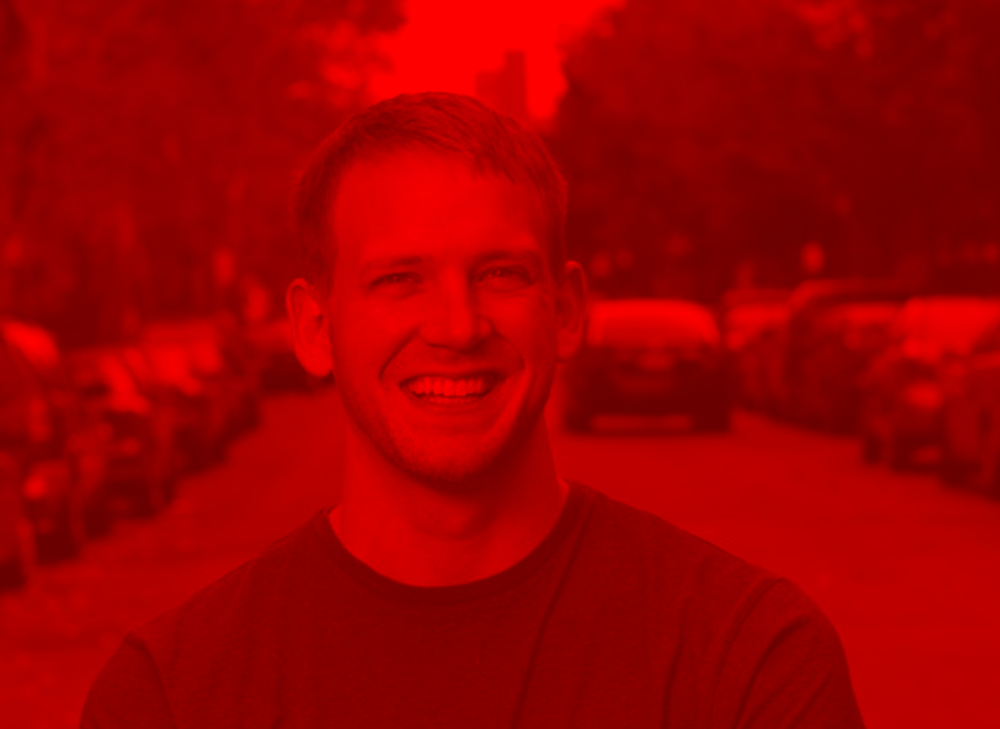 ALAN COREY is a 39-year-old career consultant, entrepreneur, comedy writer, speaker, and straight guy. Originally from Atlanta, GA, Alan moved to Brooklyn at the age of 22 to pursue a career in real estate. Alan procured a six-figure salary by the time he was 28 and has written several guide books about his entrepreneurial success, the most well-known of them A Million Bucks by 30. His work promotes tactics of strategic and spartan living. He has also written a book on job hunting.
ALAN COREY is a 39-year-old career consultant, entrepreneur, comedy writer, speaker, and straight guy. Originally from Atlanta, GA, Alan moved to Brooklyn at the age of 22 to pursue a career in real estate. Alan procured a six-figure salary by the time he was 28 and has written several guide books about his entrepreneurial success, the most well-known of them A Million Bucks by 30. His work promotes tactics of strategic and spartan living. He has also written a book on job hunting.
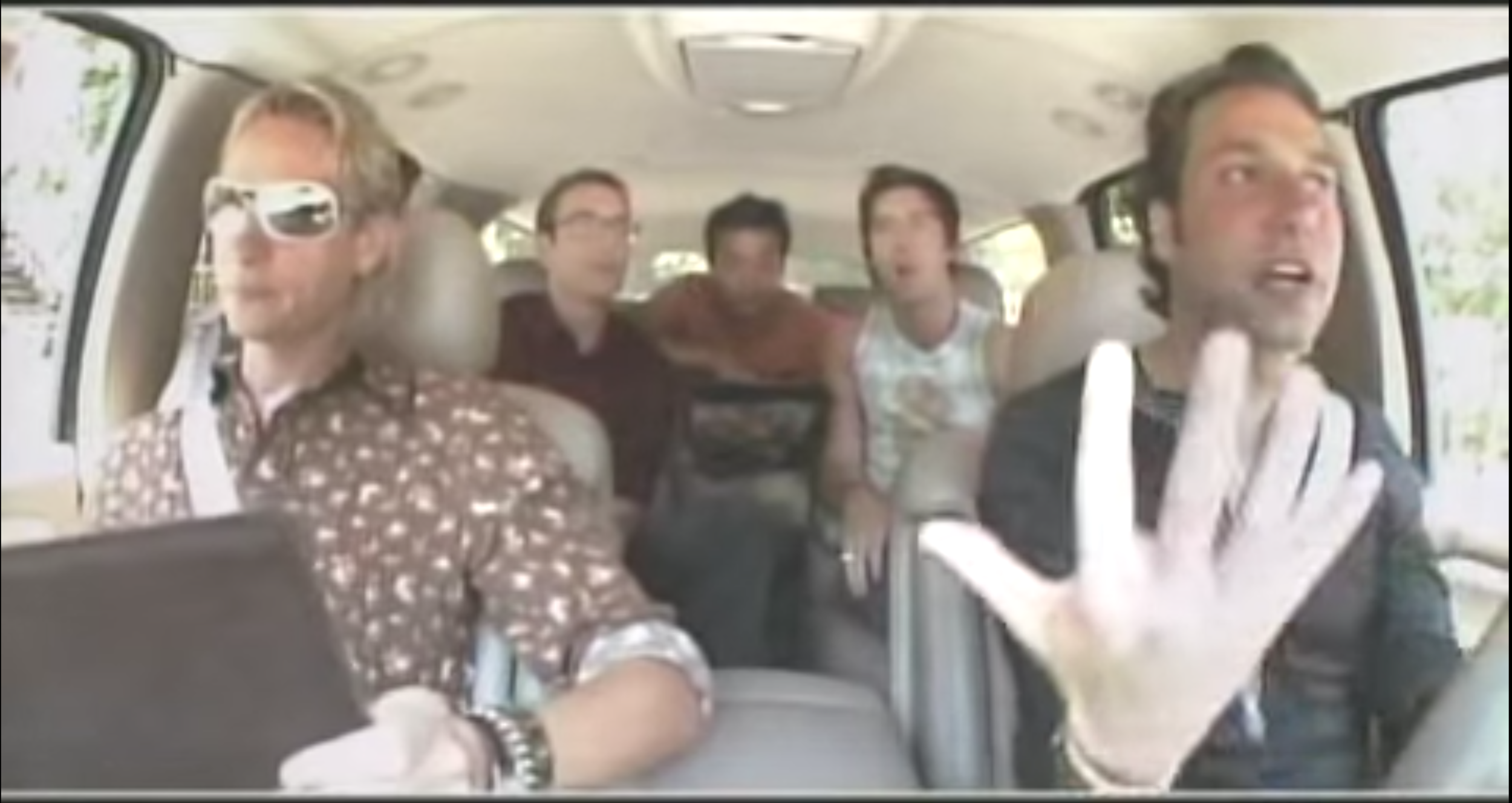
The Fab Five jump into a black SUV on a Manhattan city street and begin reviewing a dossier with information on this episode's subject, ALAN COREY.
JAI RODRIGUEZ: Let's talk about Alan Corey.
JAI RODRIGUEZ: Alan owns a one bedroom condominium that he rents out. He also bought a seven bedroom house in Brooklyn.
THOM FILICIA: He is a real estate tycoon.
From the get-go, aesthetics are detached from the normative understanding of the economy of a site—in other words, real estate—which mirrors the show’s broader understanding of the decorative as primarily a mechanism for the production of social relations.
Here, decorating is, for the most part, not viewed through its potential to increase the value of the apartment, even as Alan is a real estate “tycoon”. But that being said, decorating is, without a doubt, presented as functional—its telos is to please parents/spouse/partner.
Architecture remains stubbornly attached to “this economy of necessity, a teleology of Dwelling…. It is always a question of putting architecture in service, and at service,” notes Jacques Derrida in Pointe de Folie: Maintenant L'architecture. But the economy (oikonomia) of this Queer Eye’d house (oikos) is expanded to include larger social relations beyond those governed by transactions. It also noteworthy that in the process, a good deal is consistently celebrated in Queer Eye for the Straight Guy, and decorating is untethered from its typical association with the wealthy class.
As a straight man, Alan’s personal self-worth is untethered from the physical: from his body, his appearance, his relationship, his home. In contrast, for the Fab Five, as queer men, the development of identity is inexorably tied to negotiating their bodies in space, to their attachment to the material.
KYAN DOUGLAS: He's taking his relationship to the next level. His parents are meeting his girlfriend's parents.
Alan’s Queer Eye transformation is motivated by his desire to please his girlfriend. The resistance he demonstrates to the Fab Five’s suggestions throughout the show indicates the transformation functions as an obligation rather than an action for personal fulfillment. Again, the aesthetic qualities of space only bear real significance to the female/homosexual members on the show.
THOM FILICIA: He's introducing the parents. It's a very stressful time in a boy's life.
There is a certain detachment from, yet focus on, the developmental stages of a normative heterosexual identity—stages the gay man constitutively does not experience. Here and elsewhere, the homosexual is shown to have knowledge of the very cultural norms and configurations from which he is excluded—more, in fact, than the heterosexual. This echoes other cultural representations of homosexuals as possessive of a secret, unusual and superior perspective towards “life, love, and matters of taste in general.” (David M. Halperin, How to Be Gay, 10) It is as if to say, the outcast knows the home better than the resident.
TED ALLEN: I'm thinking we're going to throw some sort of an event that involves the parents meeting one another. Maybe we have some cocktails, maybe we have some elegant cocktails.
This is precisely one such event that many gay men, especially at the time of this episode’s filming, would never experience. It is important to remember while watching the show that despite increasing public acceptance of homosexuality (to some degree influenced by cultural representations like this show), 40% of Americans currently do not think homosexuals should be accepted. In 2003, it was 49% (Pew Research Center).
On the other hand, just as there is a correlation between knowledge and acceptance, there is likely an (understudied) relationship between the codification of homosexuality as a recognizable public identity and its rejection.
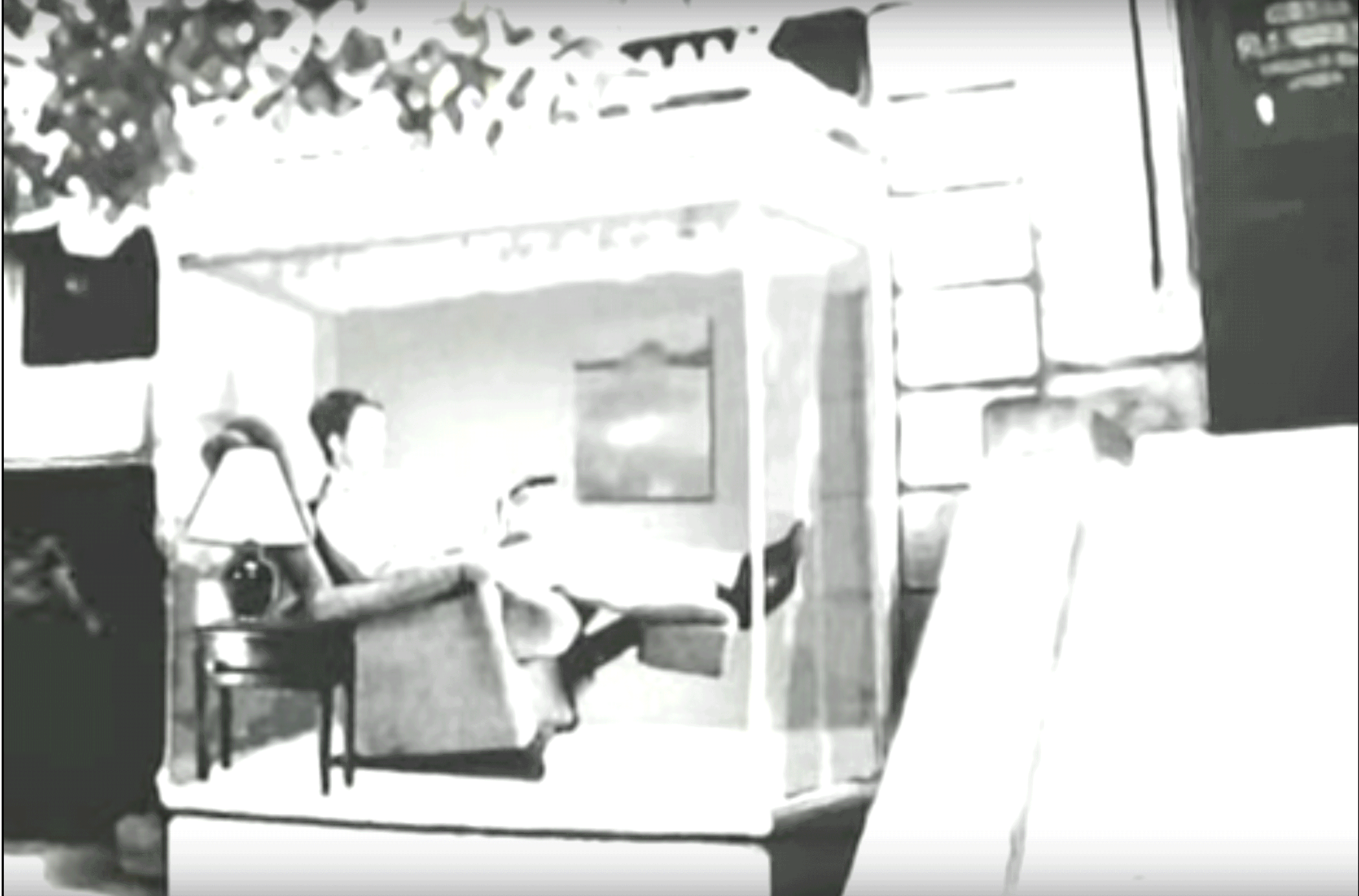
Break for the Queer Eye intro montage and theme song. Next, the Fab Five pull up in front of ALAN's apartment in Brooklyn and rush inside.
JAI RODRIGUEZ: Alan, we're coming for you.
A coy and suggestive flirtation dominates the cast’s relationships with the straight participants. Rather than actually suggesting the possibility of sexual consummation, this flirtation reinforces its impossibility.
“To draw the ‘homosocial’ back into the orbit of ‘desire,’ of the potentially erotic, then,” writes Sedgwick in Between Men: English Literature and Homosocial Desire, “is to hypothesize the potential unbrokenness of a continuum between homosocial and homosexual—a continuum whose visibility, for man, in our society, is radically disrupted.”
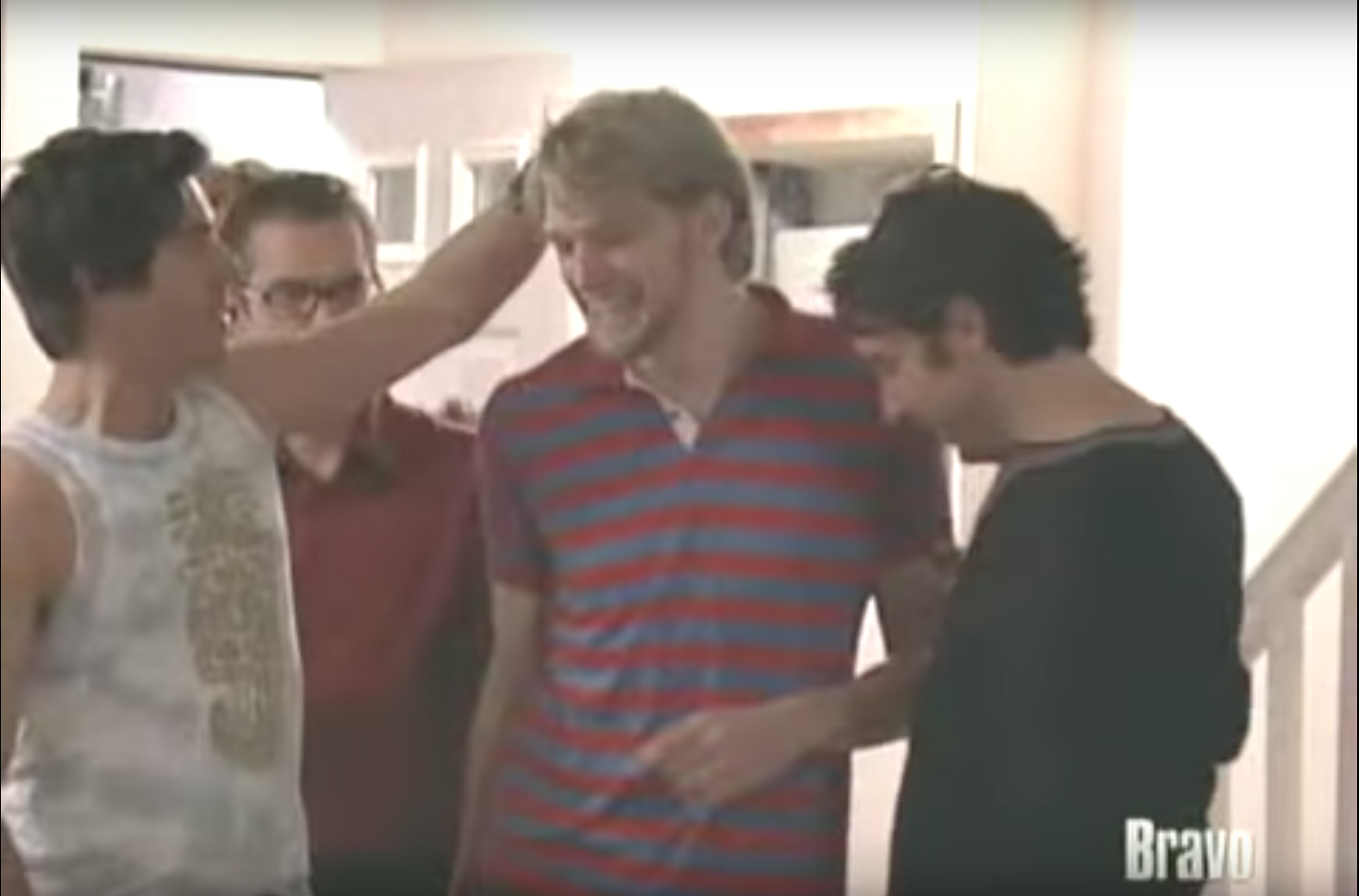
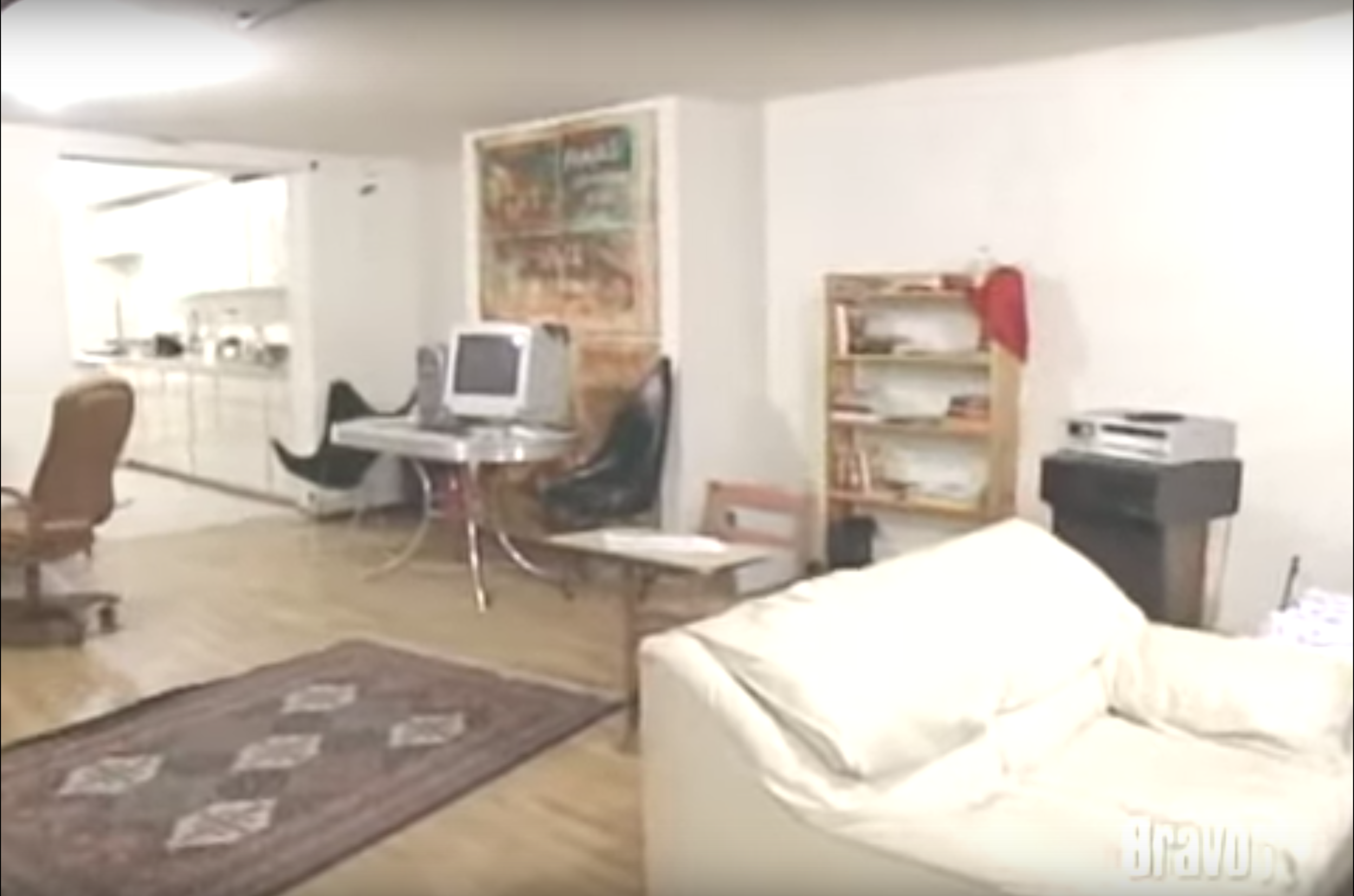
The Fab Five begin to assess the state of the apartment. CARSON paws ALAN's clothes.
CARSON KRESSLEY: Who are we wearing here?
ALAN COREY: Jeans I got for like a dollar, a shirt I got-
CARSON KRESSLEY: A dollar.
ALAN COREY: ... $0.50.
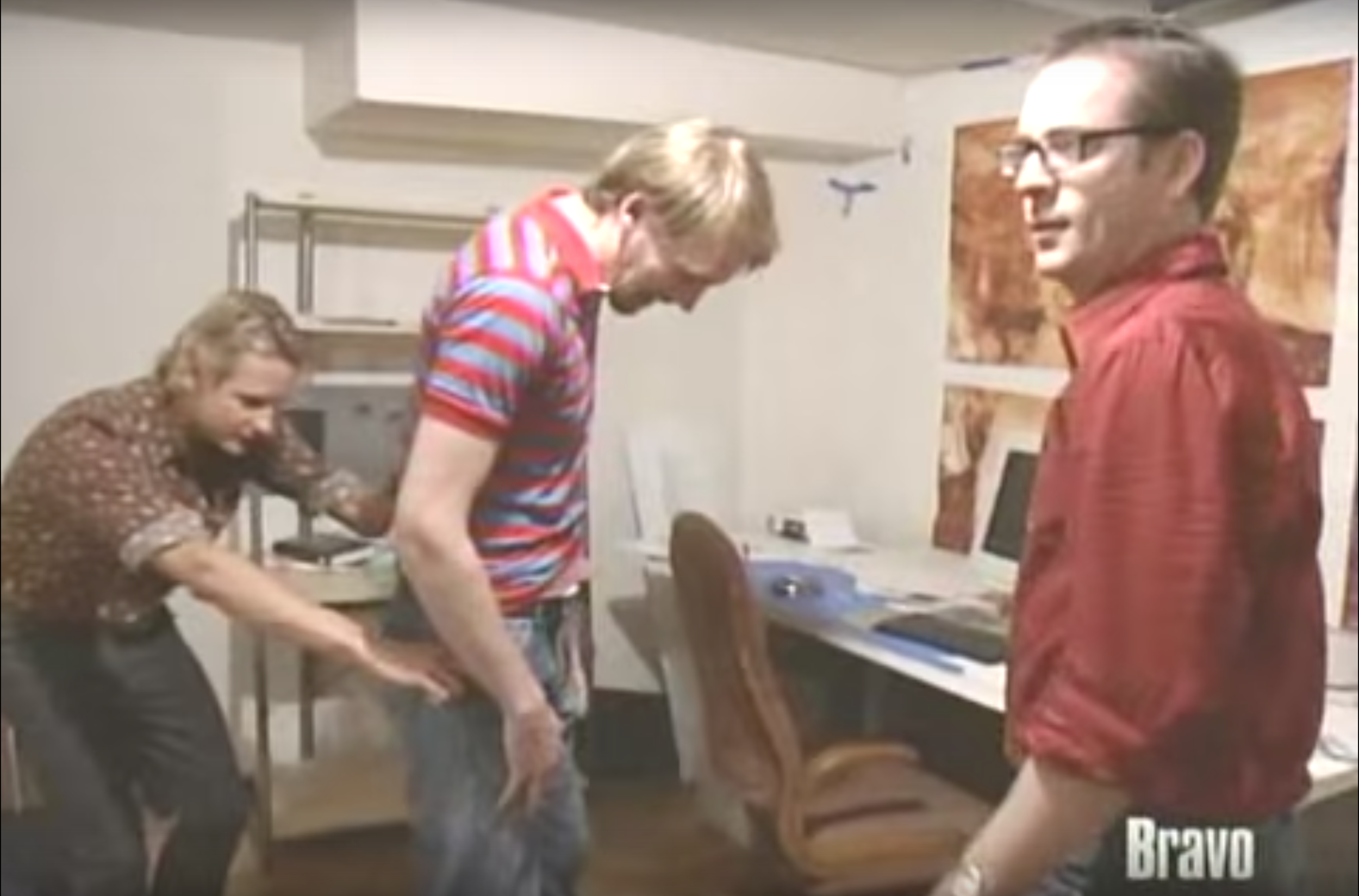
Alan exhibits pride for how little he has spent on his clothes and furnishing for his apartment. Spending money on material goods is considered a vain and trivial act from his position as a heterosexual man. On the flip side, it is seen almost as a requirement of women and gay men to sink a portion of their income on clothes and products to merit a level of public respectability.
KYAN presents ALAN with one of his rugs.
KYAN DOUGLAS: Hey, Alan, do you think that looks good?
ALAN COREY: For the money, it looks good.
KYAN DOUGLAS: How much was it?
ALAN COREY: It was free.
KYAN DOUGLAS: I think I see a theme here. It's free.
Frugality is posited as the opposite of taste. Decorating is synonymous with consumption, even if done on a budget.
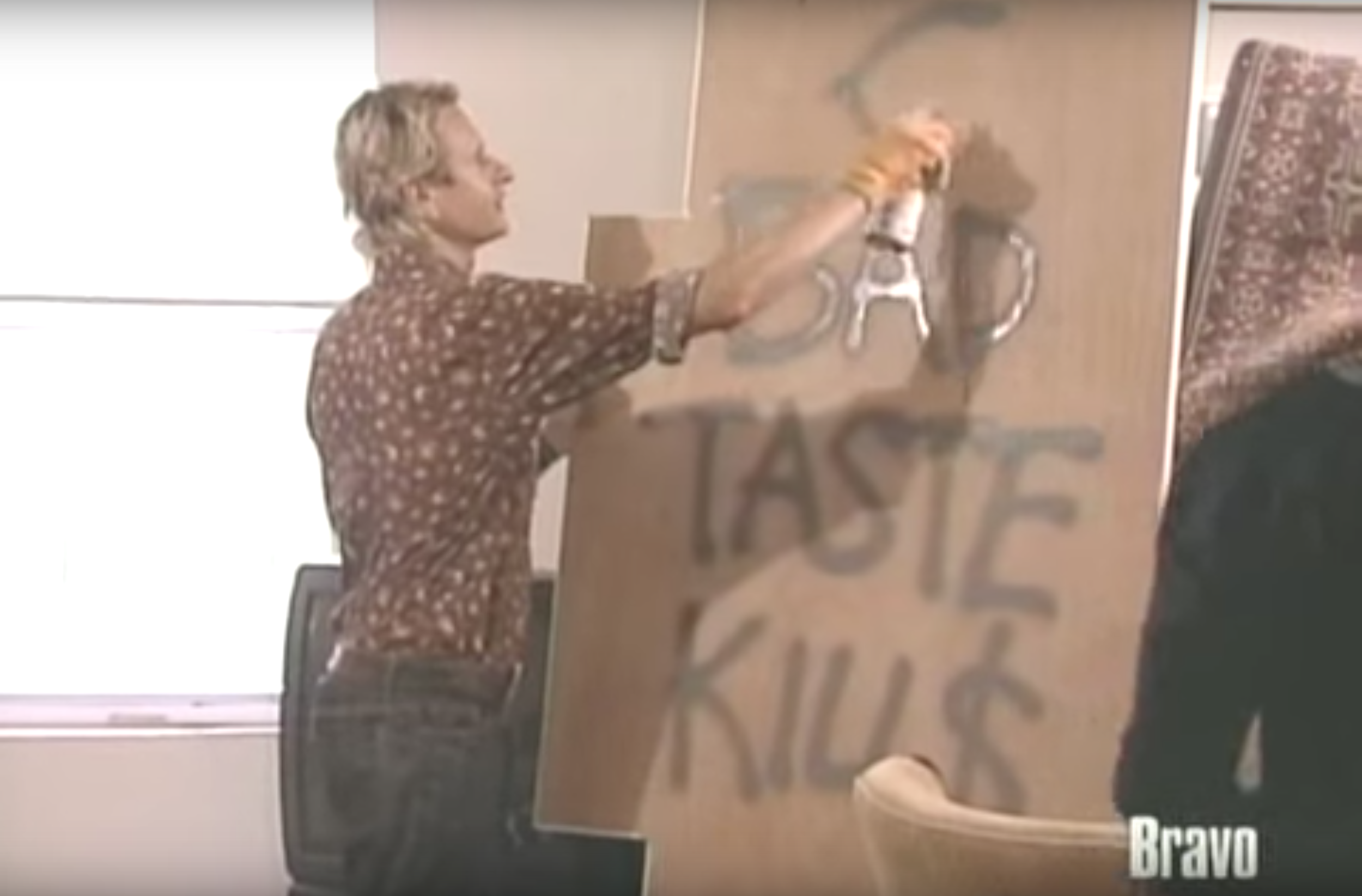
CARSON spray paints "BAD TASTE KILL$" onto the back of ALAN’s desk (door).
CARSON KRESSLEY: Bad taste kills.
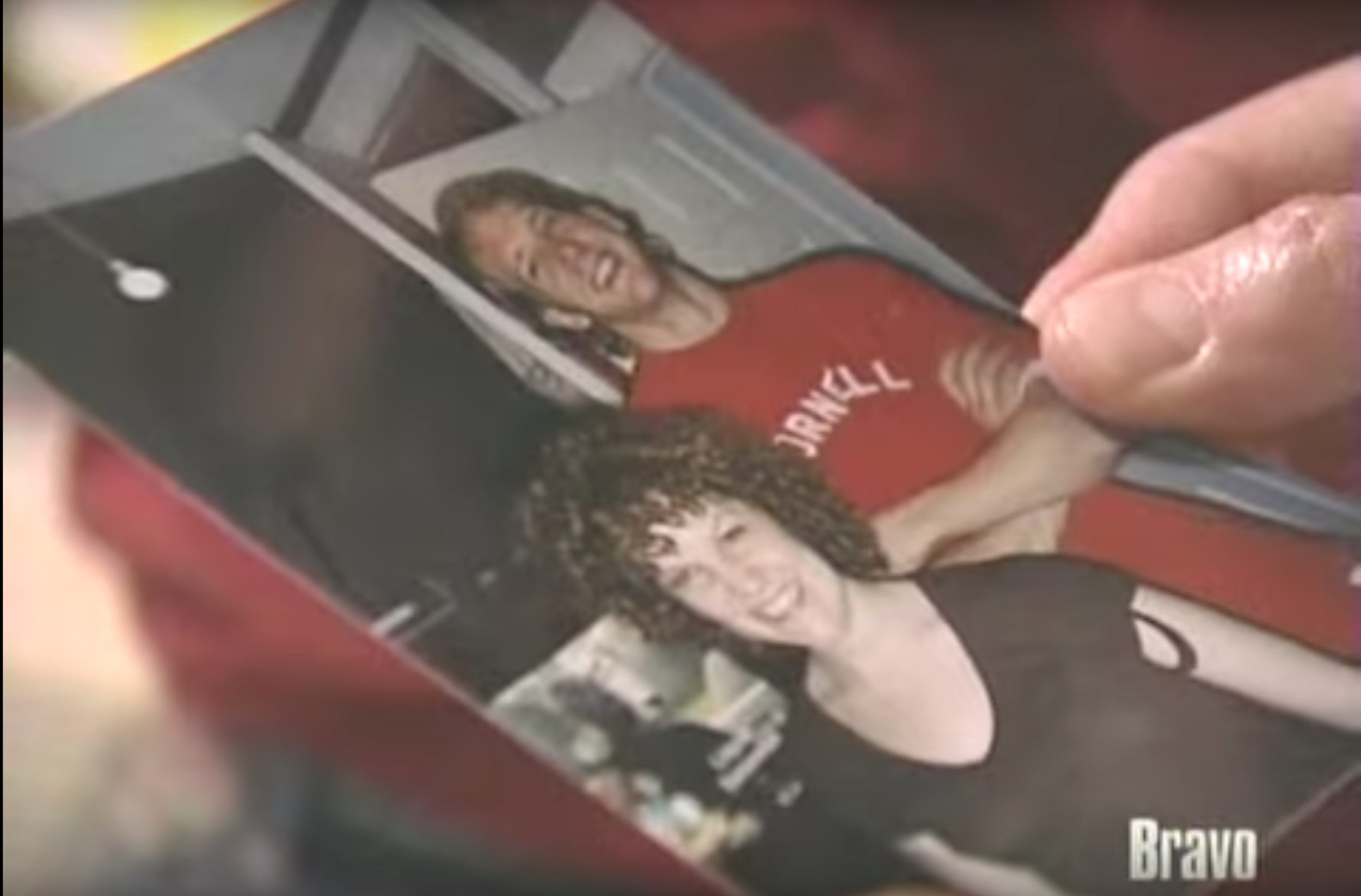
THOM holds up a picture of ALAN’s girlfriend, KATIE.
THOM FILICIA: She's cute. Good hair, nice, perky breasts. She's a keeper. You better hope she doesn't dump your ass.
The homosocial relationship between the gay men and the straight man is often constituted through a shared recourse towards objectifying the women on the show. Masculinity here is defined as a shared non-femaleness that surpasses sexual identity.
“The erotic and social presumption of women is our enemy,” Benedict Friedländer wrote in his “Seven Theses on Homosexuality.”
At the same time, “the suppression of the homosexual component of human sexuality, and by corollary, the oppression of homosexuals, is…a product of the same system whose rules and relations oppress women,” notes Gayle Rubin in “The Traffic in Women: Notes on the 'Political Economy' of Sex.”
CARSON drags ALAN to his bedroom.
CARSON KRESSLEY: Let's go to your bedroom.
Here, the gay man arbitrates the norms of the home, which correlates to a gendered power structure that transcends sexuality. A woman’s place may be the home, but she does not control it. This is an historical dynamic that reaches back to (at least) the Greeks, when the oikos was the man's possession, and the woman's prison (women were, literally, confined to not just the home, but one region of it—the andron).
At the same time, this is a dynamic that is thoroughly historical, mutating according to changing socioeconomic conditions, notably the emergence of capitalism for the sake of this context (Alan as "real estate tycoon").
“The man who has this [idealized] home is a different person from the lord who has a castle; and the forms of property implied in the two possessives (his [mortgaged] home/his [inherited] castle) are not only different, but as [Juliet] Mitchell points out, mutually contradictory. The contradiction is assuaged and filled in by transferring the lord’s political and economic control over the environs of his castle to an image of the father’s personal control over the inmates of his house. The ideological formulation thus permits a crisscrossing of agency, temporality, and space.” (Sedgwick, Between Men)
In ALAN’s bedroom, CARSON examines one of ALAN’s boots.
CARSON KRESSLEY: This is patent leather and it's a hiking boot. For all those formal rock climbing events.
ALAN COREY: I didn't know what patent leather meant at the time. I got it online.
Straight masculinity is recurrently posited as the refusal of knowledge of aesthetics, particularly that concerning fashion.
“Ignorance and opacity collude or compete with knowledge in mobilizing the flows of energy, desire, goods, meanings, persons,” writes Sedgwick in Epistemology of the Closet.
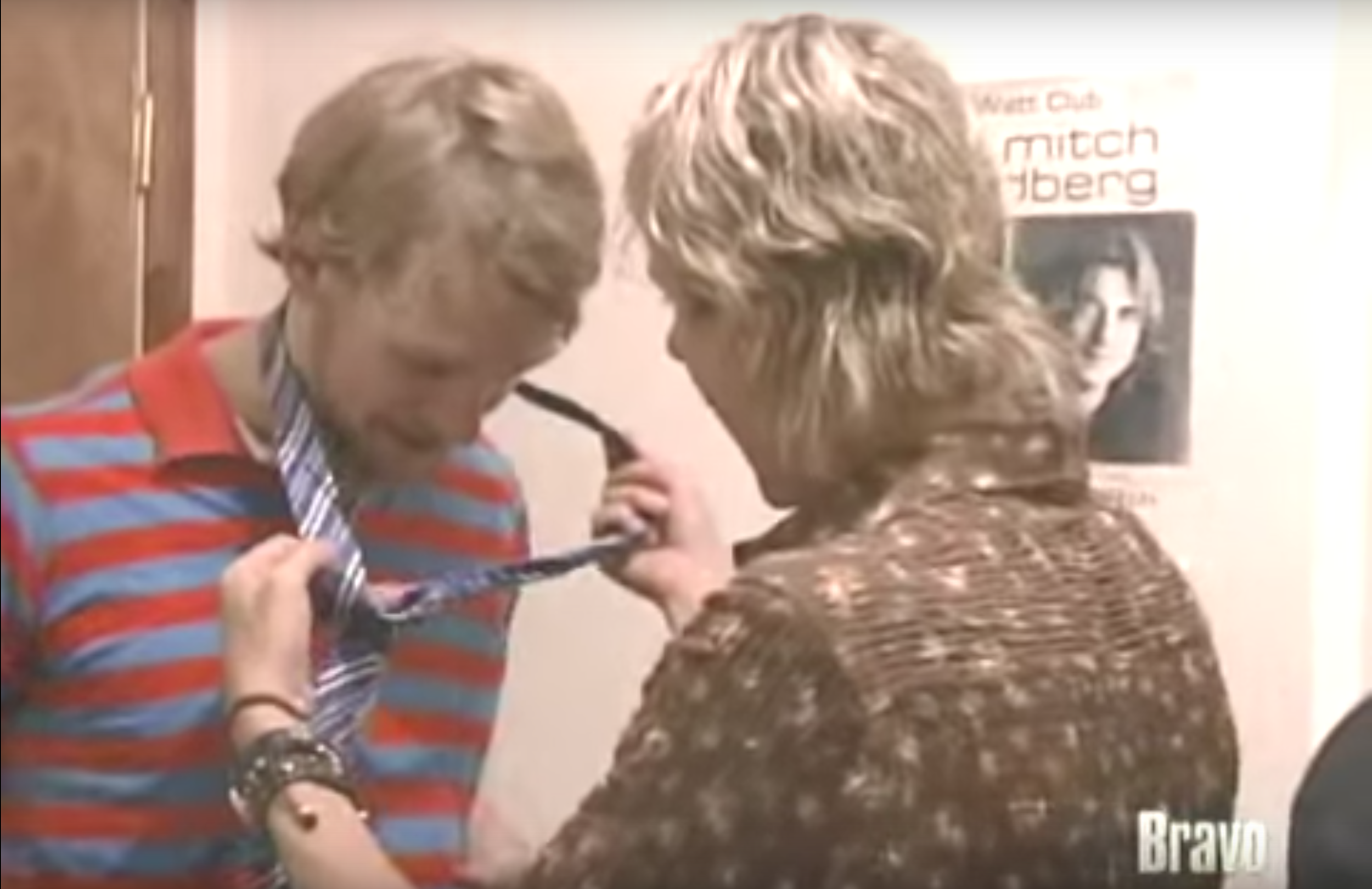
In the bedroom, CARSON is attempting to tie a tie around ALAN's neck.
ALAN COREY: This doesn't interest me. I have no—
CARSON KRESSLEY: I know, but you need to learn this.
The show operates according to complex configurations of power relations: the gay man is at once pedagogue and yet, in possessing a secret knowledge, outside of a claim to actual power.
In order to furnish the heterosexual man with the trappings of a dynamic, well-rounded, well-cultured individual, the Fab Five must compress themselves into highly concentrated and one-dimensional archetypes of taste.
ALAN COREY: It's a goal of mine never to wear a tie again.
CARSON KRESSLEY: Do you want to get a loan? For your next big building?
ALAN COREY: I've gotten loans already, that's fine.
CARSON KRESSLEY: On the internet, probably.
ALAN COREY: It worked.
The straight man performs a strict logical coherence in relation to economics.
TED and ALAN are in the kitchen.
TED ALLEN: All right, you've got a problem with drinking cheap liquor. Totally understandable to try to save money in the right places, but you got to pick the right places to cut corners.
ALAN COREY: All places, all places.
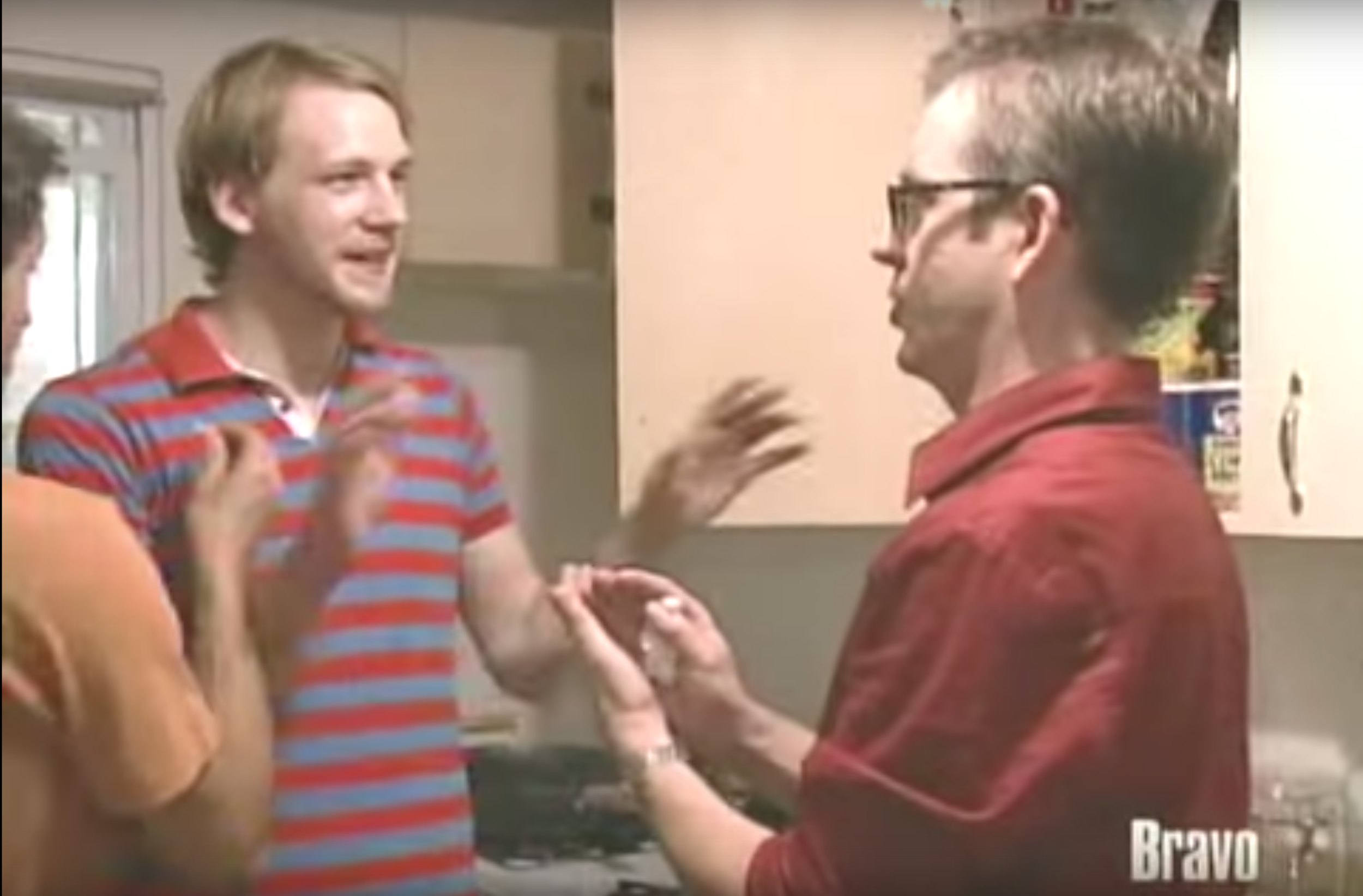
For Alan, the prototypical straight cis male, the topology of economic thinking is a flat sameness.
TED ALLEN: We'll have to ask Carson what he thinks ... What you want to do is have your parents meet KATIE's parents. Obviously, you're trying to impress them. Am I correct?
ALAN COREY: Correct.
TED ALLEN: They're probably going to be less impressed with a keg than I would be.
ALAN COREY: Right, right.
TED ALLEN: Since the goal is we want to throw an event that's a little bit more adult, a little more grown up, a little more sophisticated.
ALAN COREY: I'll do that.
Straight masculinity is recognized as infantile.
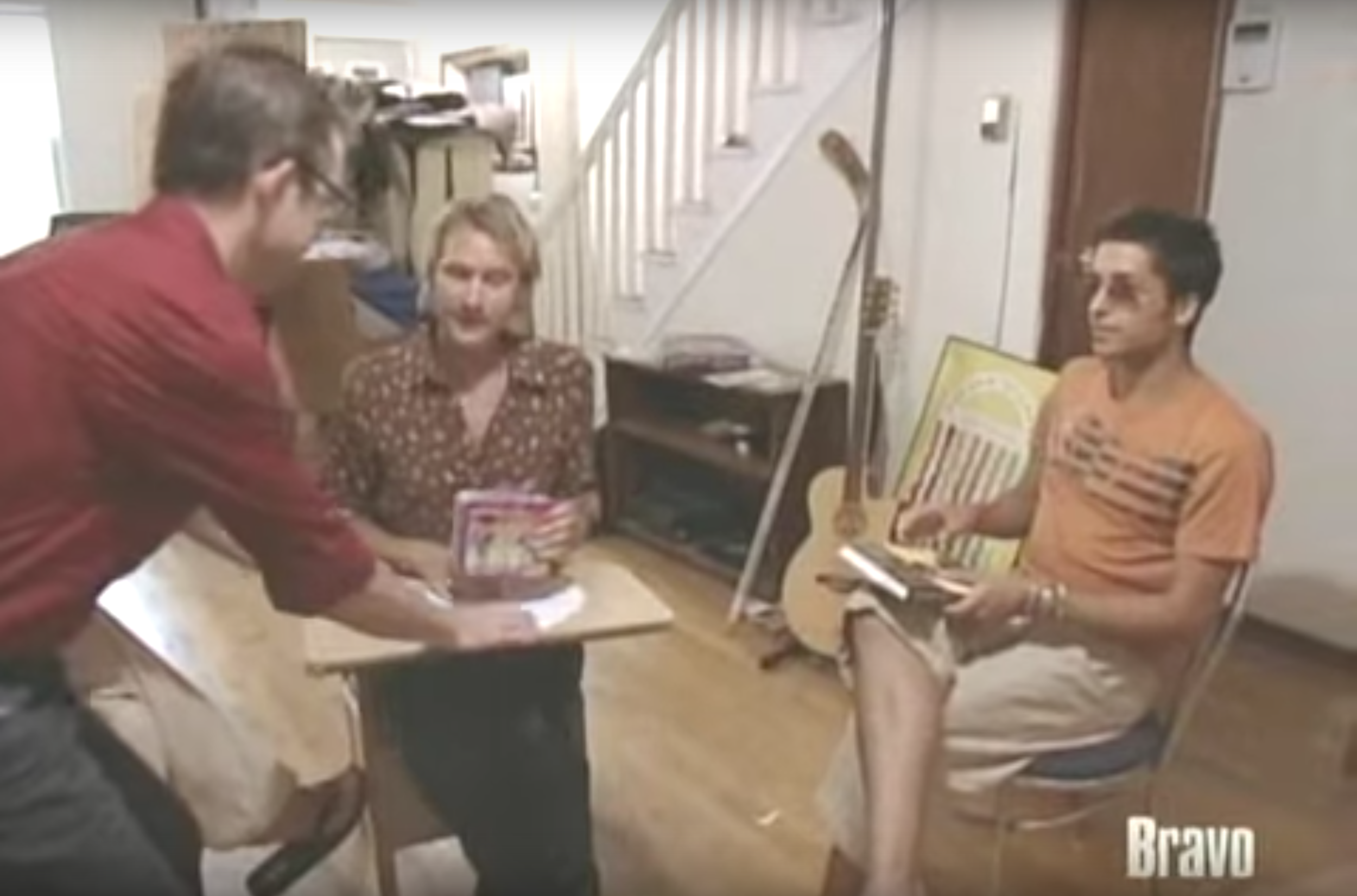
CARSON and JAI are seated at elementary school desks in the living room with TED.
TED ALLEN: Would you like a grease-proof doily for your desk?
CARSON KRESSLEY: Thank you, Mr. Allen.
JAI RODRIGUEZ: Mr. Allen, I'm going to need to ask you to take your seat. We are having a reading from Trump's latest The Art of the Comeback.
Cut to ALAN and KYAN in the bathroom.
ALAN COREY: After you guys tore it up, yes.
KYAN DOUGLAS: No, it was a shit hole before we got here.
An infantile resistance to criticism. Alan childishly defends the state of his home even after signing up for an apartment overhaul.
Cut to JAI in the kitchen.
JAI RODRIGUEZ: (singing)
Male homosexuality is assimilated into straight culture as sentimentalized spectacle.
Cut to THOM and ALAN in the living room.
THOM FILICIA: You're not really using the space. It just looks like you blindfolded yourself, walked around the neighborhood on like trash night, dragged this stuff back to your house, and then you had your desk over here and it was just a big hallway. Go ahead, tell me your vision.
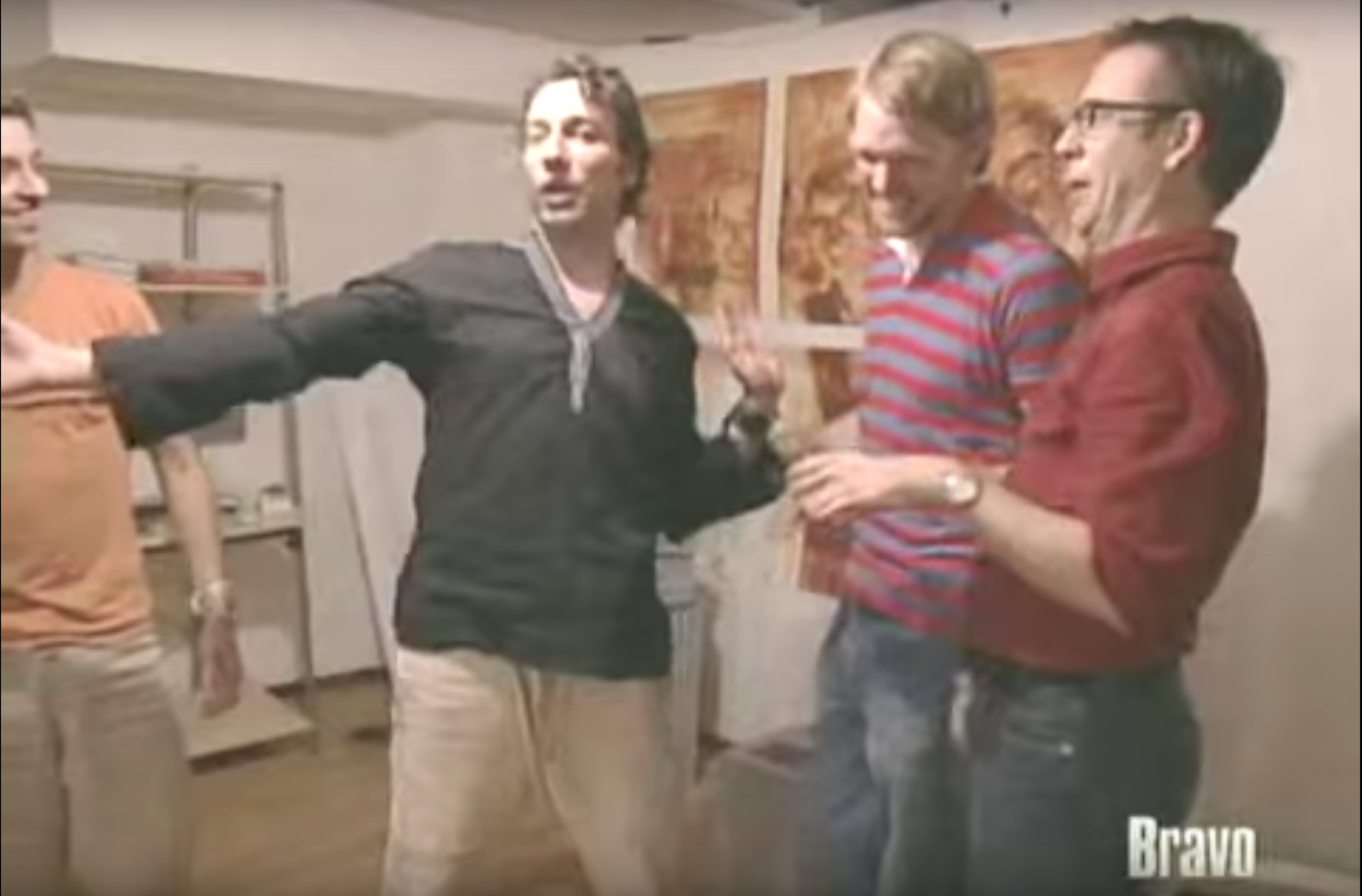
Thom names a foundational component of decorating: the projected space imagined before acting. Here it is privatized, reserved for gay men—the clean and savvy. At the same time, this suggests an economic dynamic, wherein “vision” is excessive, accessible for those who exist outside of labor (the domain of the straight man) and instead at leisure.
ALAN COREY: I don't really have a vision. I don't-
Yet that projected space is privatized, accessible only to the clean and savvy. At least, according to Allan and Thom.
THOM FILICIA: Get out of here! You, no vision. I don't believe it.
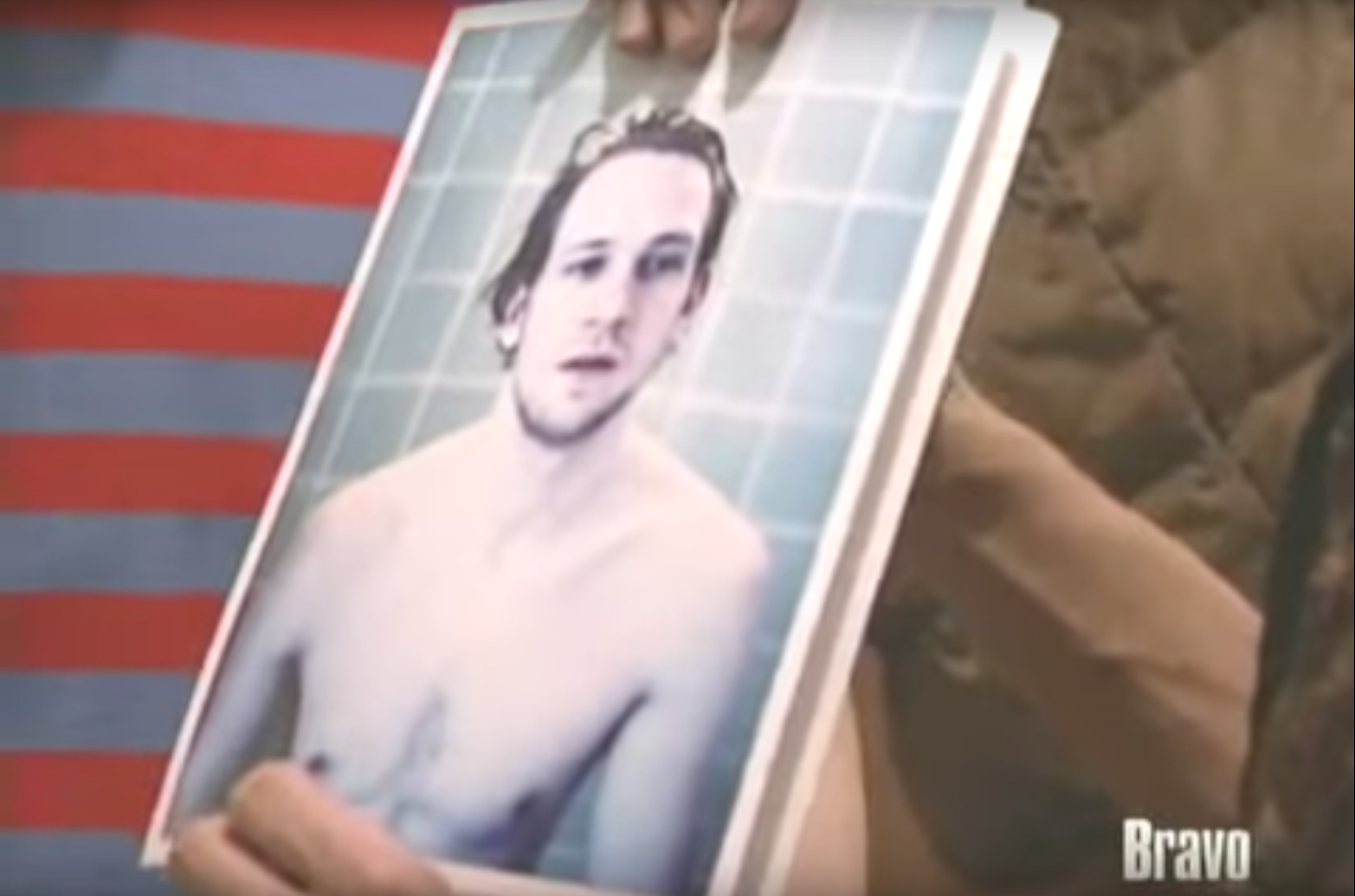
Back in the bedroom, CARSON and KYAN hold up photos of ALAN shirtless.
CARSON KRESSLEY: I think that our subject has lots of potential.
KYAN DOUGLAS: Lots of potential.
CARSON KRESSLEY: We must help him.
KYAN DOUGLAS: We must. We can rebuild him.
The show’s plot mechanism is well-described with architectural language: a group of gay men redesign both the straight male and his context.
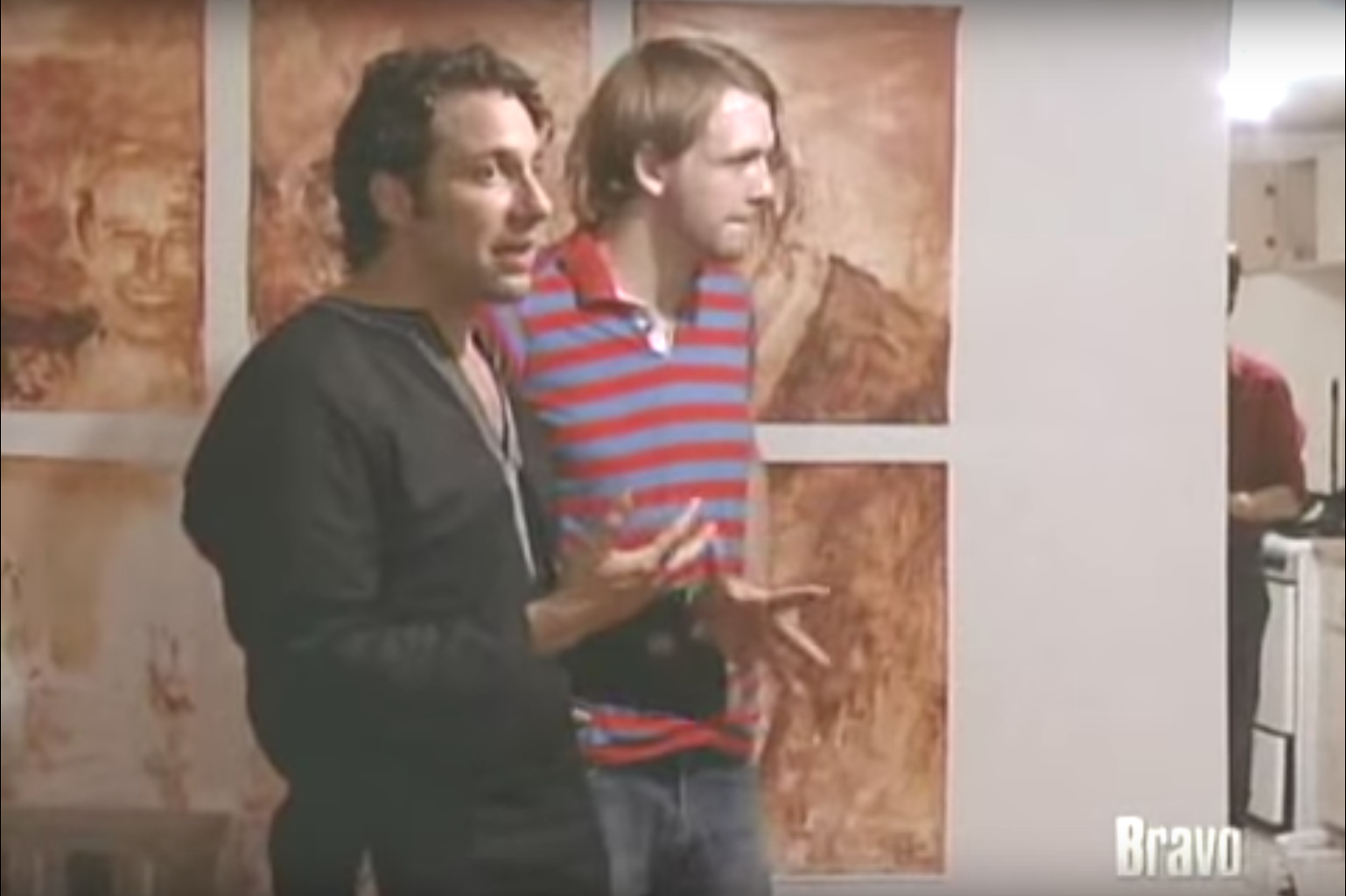
Cut to THOM and ALAN in the living room.
THOM FILICIA: The artwork you have is fantastic. I want to really highlight the artwork and give it more of a presence.
Curiously, art appears to be the only material and creative interest Alan spends money on (besides entrepreneurial guide books), which, like real estate, is coveted and collected for its cultural and monetary value, regardless of its aesthetic context.
In the bedroom, CARSON presents the photographs ALAN photographs of himself.
CARSON KRESSLEY: These gave me inspiration. These are like shots of yours. They're very cute. You're very Ethan without Uma. It kind of inspired me to give you kind of a Hollywood vintage look. We need to buy you a good suit or a nice, presentable outfit for when you have important meetings, because we want to make you that real estate mogul.
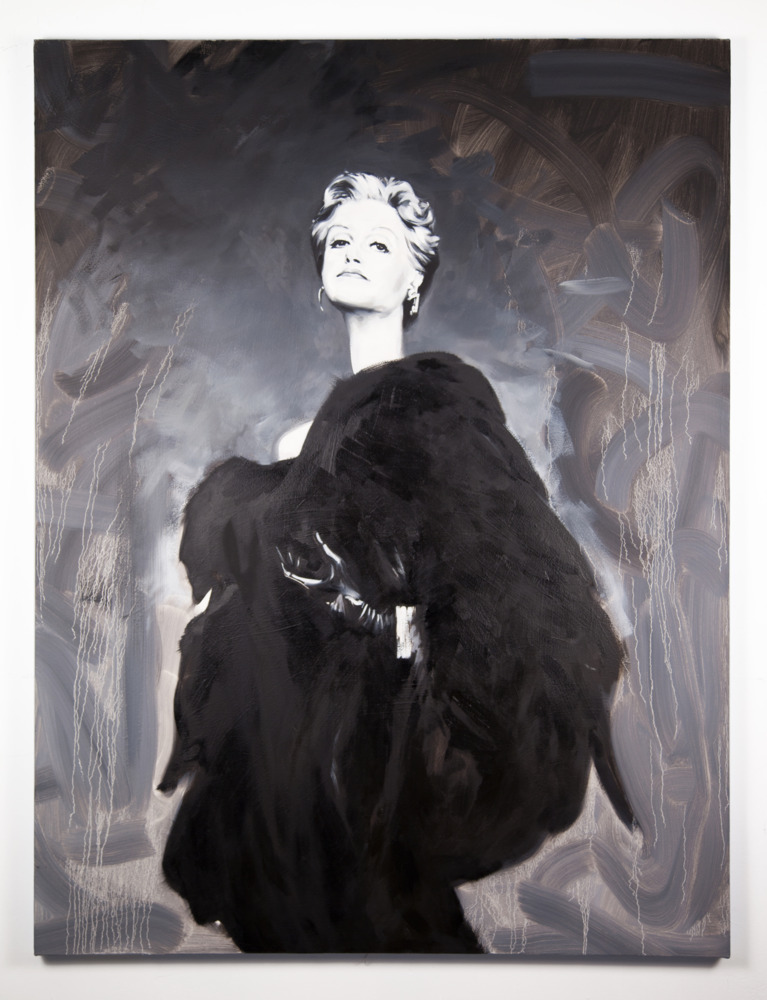
The gay man is close with pop culture, in particular certain female singers and actresses.
“As a cultural practice, male homosexuality involves a characteristic way of receiving, reinterpreting, and reusing mainstream culture, of decoding and recoding the heterosexual or heteronormative meanings already encoded in that culture, so that they come to function as vehicles of gay or queer meaning,” states David Halperin in How to Be Gay.
JAI and ALAN sit together downstairs.
JAI RODRIGUEZ: You've been dating KATIE for two years, you said?
ALAN COREY: Right.
JAI RODRIGUEZ: What's the most special thing you've ever done with her, or for her?
ALAN COREY: We don't do anything romantic. We don't, or anything date-wise.
Alan’s claim to masculinity is built upon his failure to live up to the masculine ideal. He is, in a sense, too masc to be masc. His failure is to be read sentimentally, as part of the larger shortcomings of straight men in mass media portrayals today. Pitiable figures, their assumption of victimhood further entrenches their power positions.
Several scenes later. ALAN has gone shopping with CARSON, gotten his hair cut with KYAN and picked out jewelry for KATIE with JAI. ALAN is now walking down a street with TED.
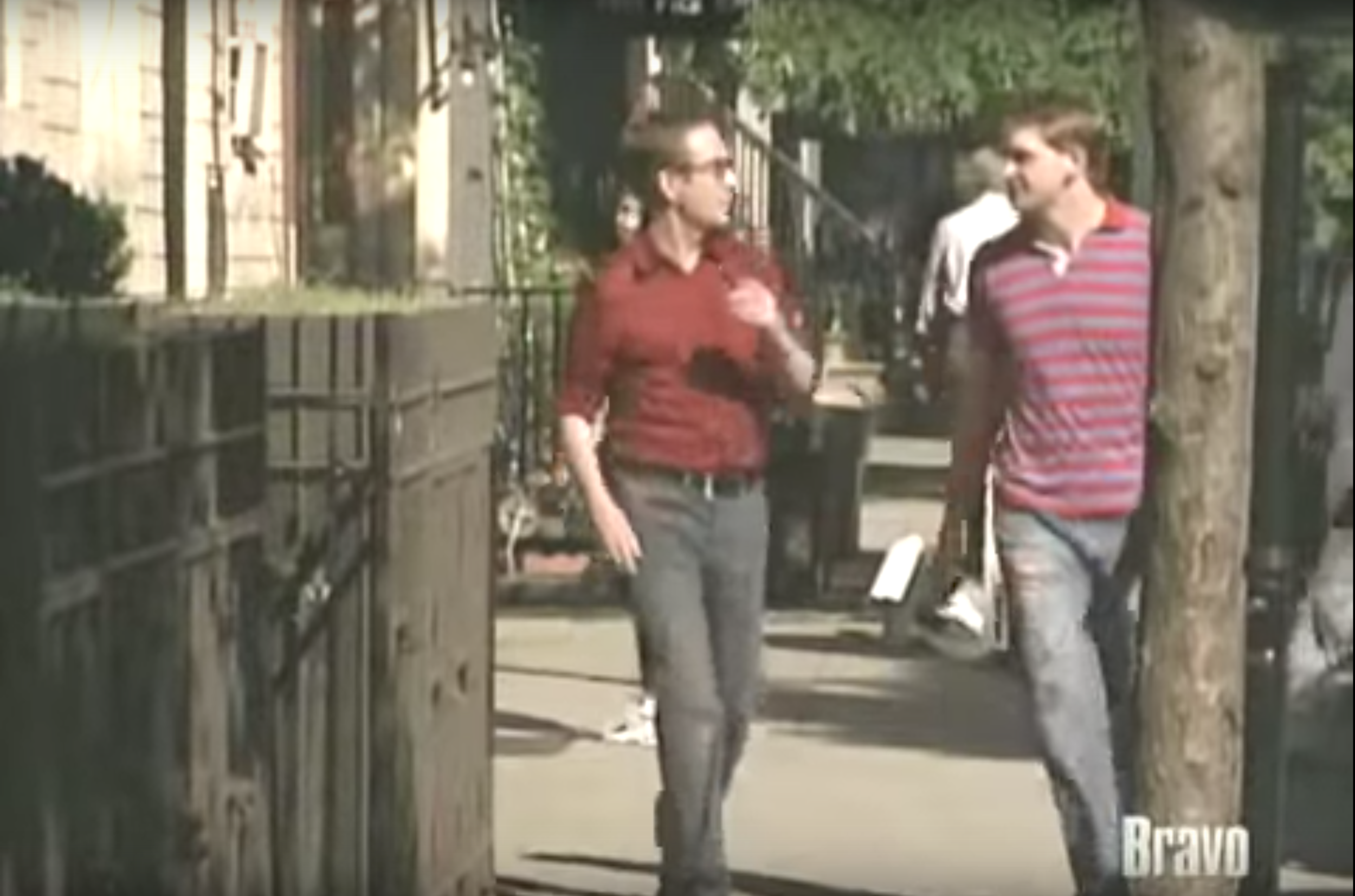
TED ALLEN: I'm going to take you now to Mr. Pink. It's an amazing shop for vintage bar ware from across the ages.
ALAN COREY: Perfect.
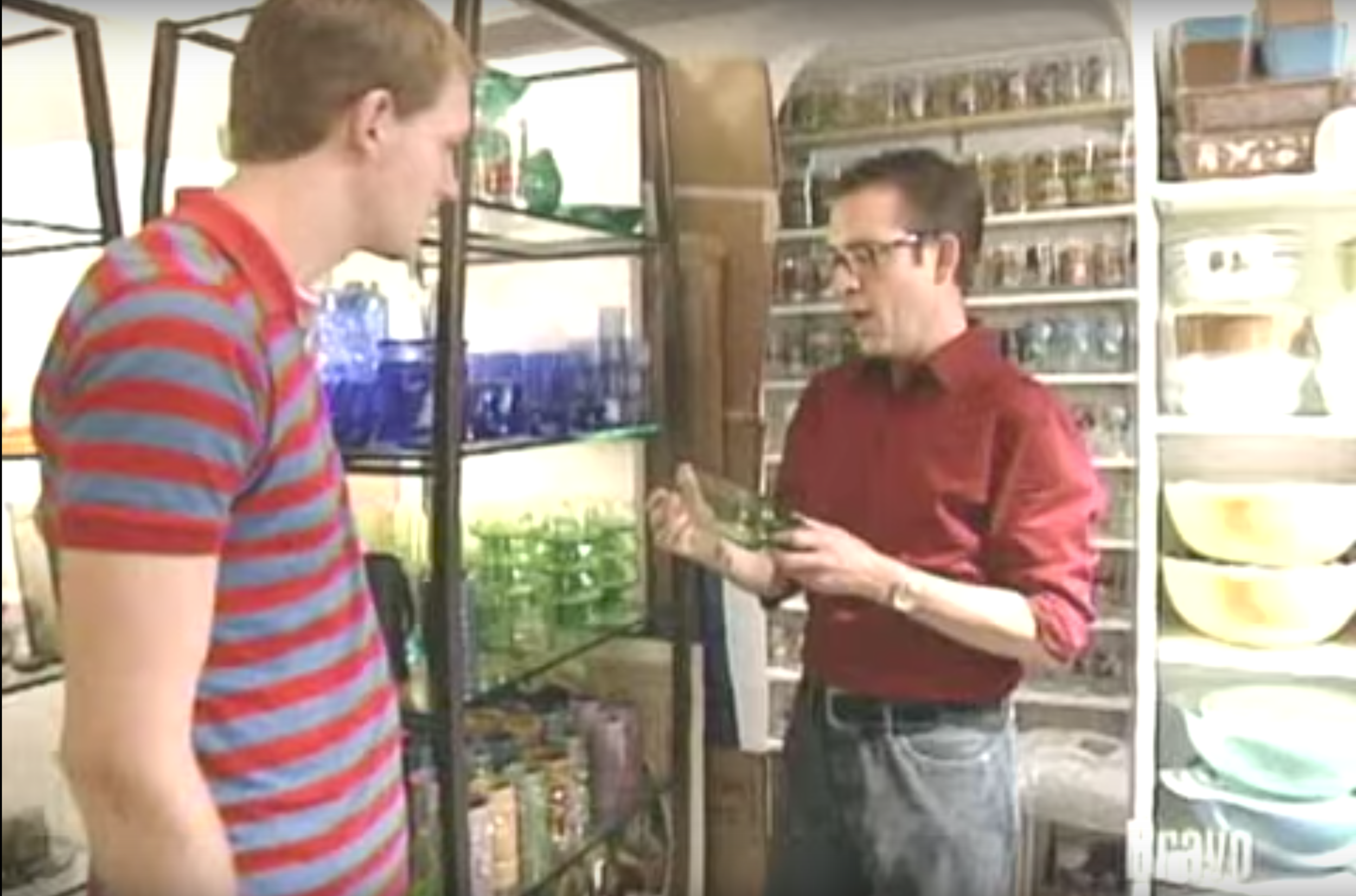
Cut to the interior of Mr. Pink.
TED ALLEN: This is Mr. Pink. They specialize in mid century stuff. A lot of stuff from the fifties and sixties and seventies. Little things like barware, just the glasses that you choose, have everything to do with the kind of message you send about the guy you are.
You are how you decorate.
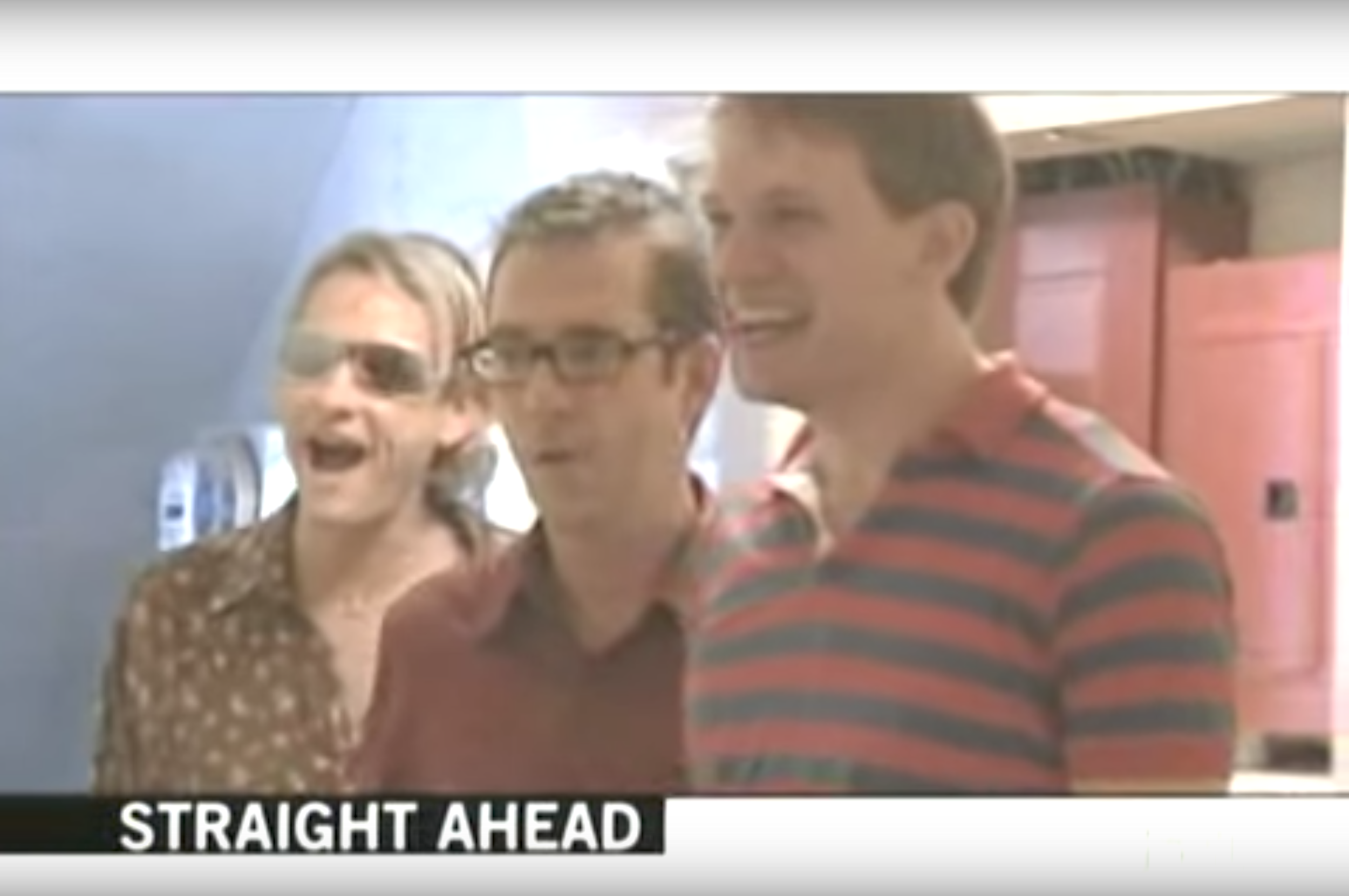
Cut to a preview for the upcoming scenes. CARSON is ushering ALAN into his redecorated apartment.
CARSON KRESSLEY: Ready or not, here we come.
ALAN COREY: Oh my God.
CARSON KRESSLEY: Wow.
ALAN COREY: This is awesome.
Ultimately, male homosexuality is represented through its potential to escape historical segregation and integrate successfully—and platonically—with straight male culture.
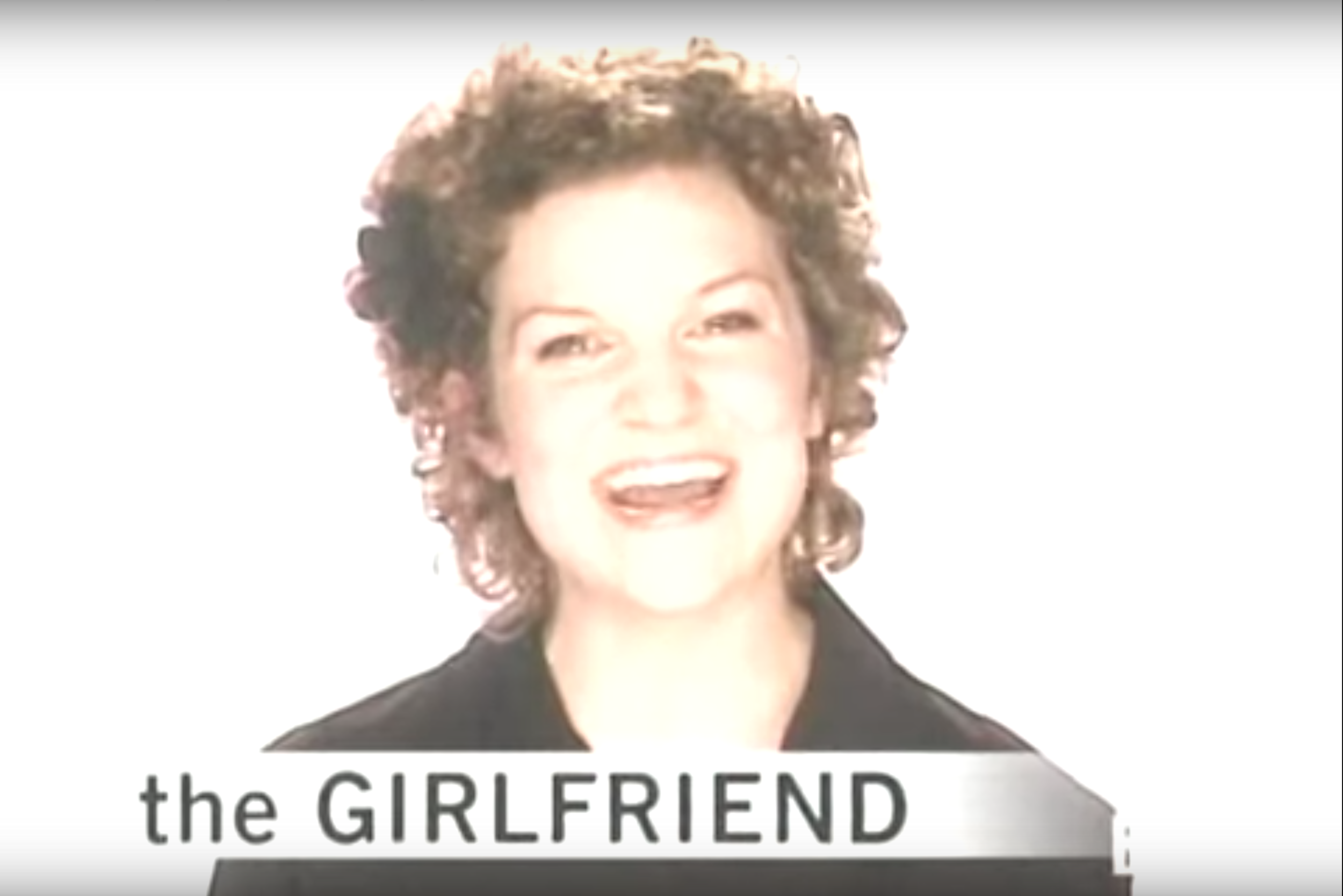
Cut to a series of interviews with ALAN's girlfriend KATIE and several friends.
KATIE: Alan's apartment is really big and it has a lot of potential, but he chooses to fill his apartment with things that he finds on the street.
The taste of the “queer eye” is defined as the innate ability to hierarchize objects by aesthetic value.
Cut to CARSON, TED and ALAN in the black SUV. TED is driving.
CARSON KRESSLEY: I have a hunch that KATIE is embarrassed about Alan's home that he keeps.
ALAN COREY: That's no hunch, that's fact.
TED ALLEN: That's fact?
CARSON KRESSLEY: That's fact. That's probably why she's never brought her parents around before.
ALAN COREY: Probably.

CARSON KRESSLEY: Unless they're like grossly disfigured coal miners from West Virginia.
“Chester and Hurley, who live in Clarksburg, [West Virginia,] say they received a knock and a note on their door on Locust Avenue at about 3 a.m. Thursday that read ‘TRUMP is our president now! Get out of our neighborhood now F—–S!’” (Charleston Gazette)
ALAN enters his newly decorated apartment, which now features a range of mid-century and contemporary furniture. The living room furniture lights up from the inside.
ALAN COREY: This is awesome.
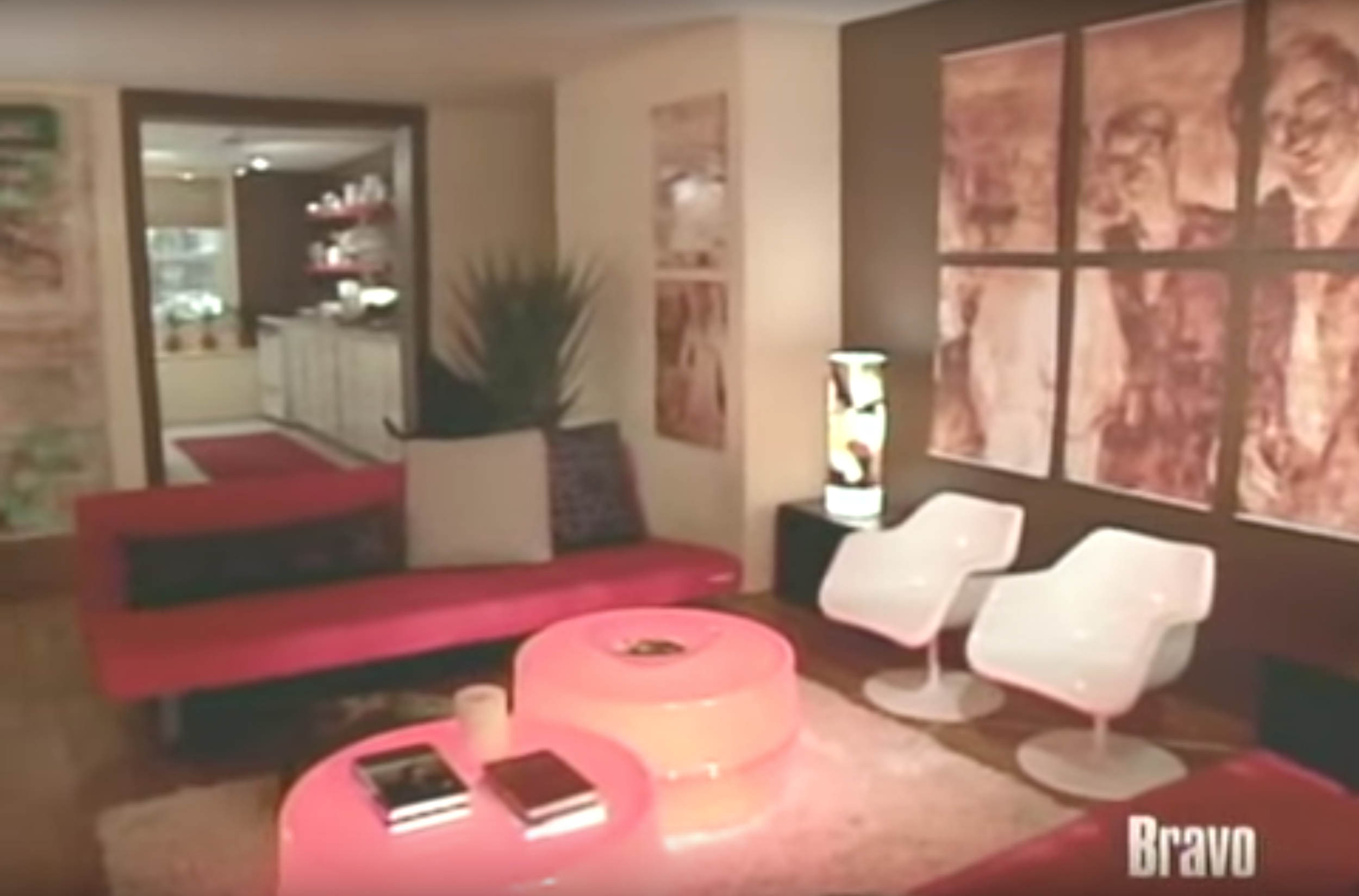
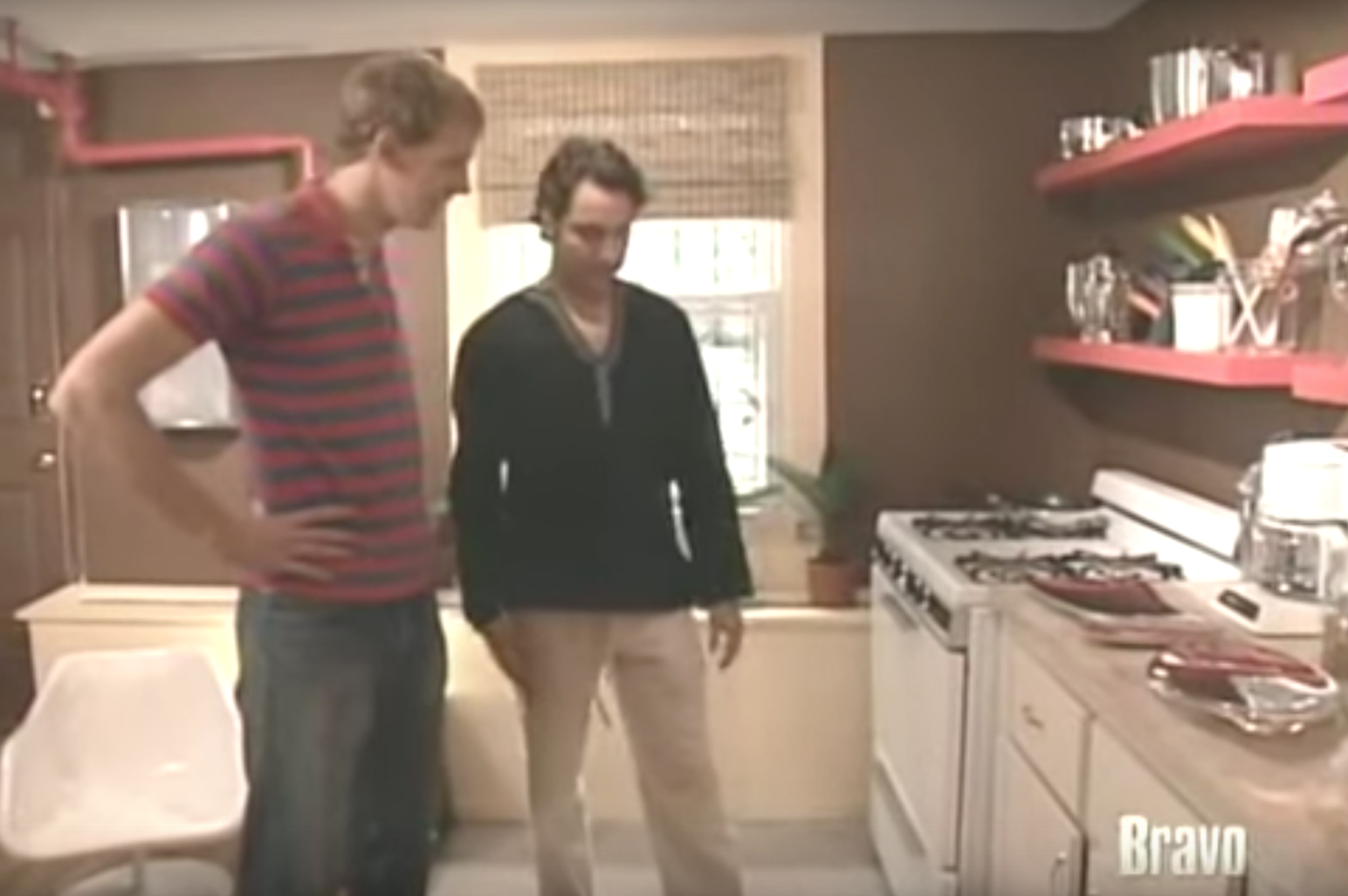
ALAN is in the kitchen, where all the cabinets have been replaced with shelves.
ALAN COREY: This is so awesome. Oh my God. This is so cool. I love those cabinets down.
THOM FILICIA: We would never know it was the same kitchen. Doesn't it make it so much bigger?
ALAN COREY: I just want to hang out in the kitchen. I've never wanted to be in the kitchen before.
Design is posited as a remedy to the vast history of the gendered division of the labor of cooking. Alongside it, the traditional—since at least the midcentury—domain of the wife is opened up to straight men.
Read the full, annotated transcript on Genius.
Adjustments Agency is a design practice founded in 2016 by Joanna Kloppenburg and Nicholas Korody. Adjustments Agency is dedicated to researching and redesigning the architecture of architecture—the forces and structures that delimit and circumscribe the possibilities of architectural thought.
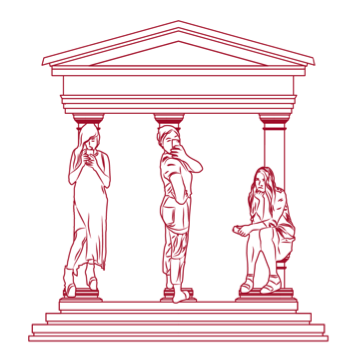
f-architecture (alt: feminist architecture collaborative) is a three-woman research enterprise aimed at disentangling the contemporary spatial politics and technological appearances of bodies, intimately and globally. Partners/caryatids/bffs Gabrielle Printz, Virginia Black and Rosana Elkhatib run their practice out of the GSAPP Incubator at NEW INC, an initiative of the New Museum.

